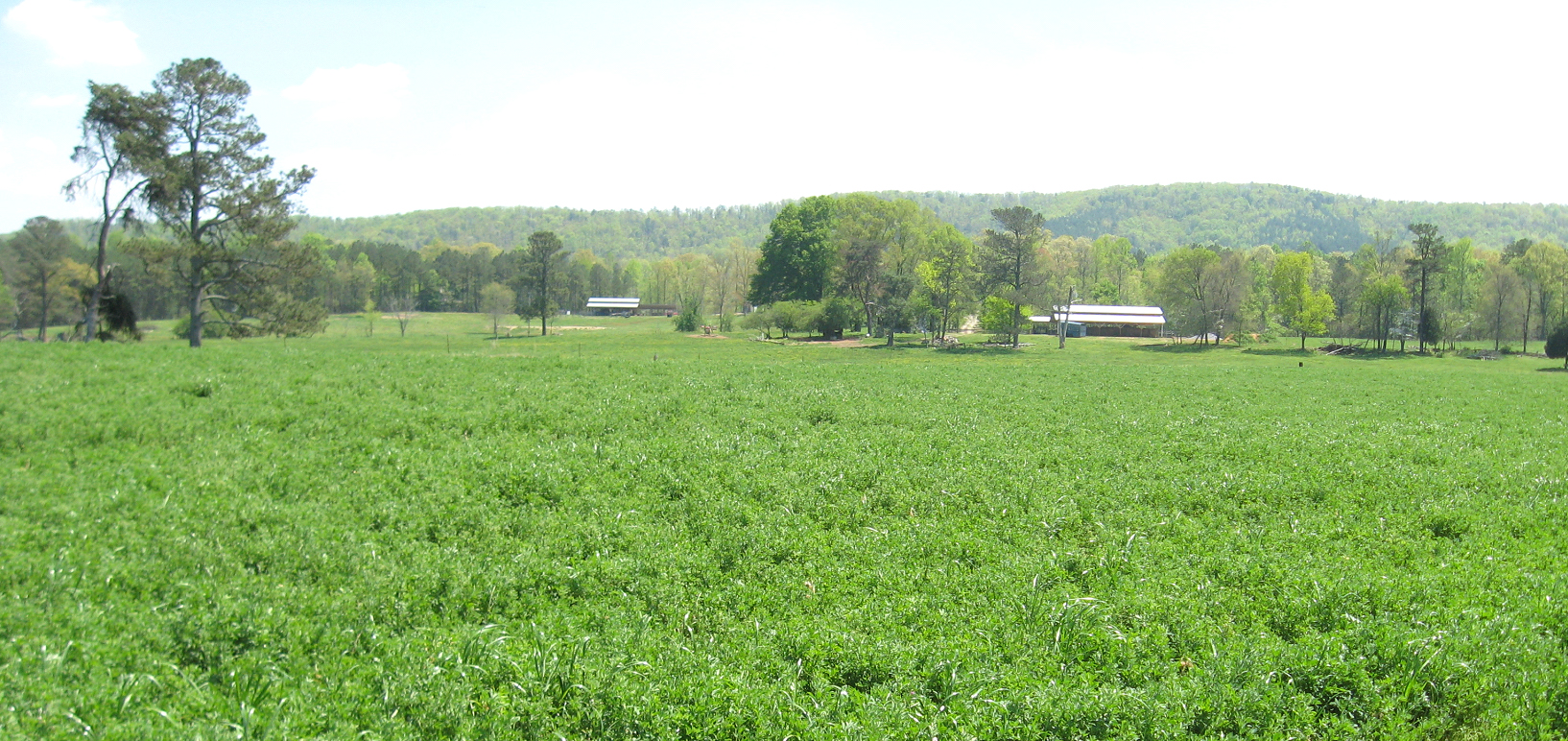 Alfalfa growing on a farm in Walker County, GA
Alfalfa growing on a farm in Walker County, GA- Introduction
- Establishment
- Fertilizing and Liming Established Stands
- Irrigation Management
- Harvest Management
- Weed Control
- Diseases
- Insects
- Alfalfa Utilization
- Economics of Alfalfa Production
- Summary
Introduction
Alfalfa is a high-yielding, perennial legume that is well-suited to hay, silage, or pasture production. Alfalfa is known as the “Queen of Forages” because it produces an excellent quality, high-protein forage. These properties make alfalfa one of the most widely-grown crops in the world.
Acreage in Georgia devoted to the production of alfalfa hay peaked in the late 1950s at around 24,000 acres. Most of this production was concentrated on the Piedmont and Limestone Valley/Mountain regions and provided high-quality forage for the dairy and beef cattle industry in north Georgia. The heavier soils in these areas tend to be more fertile and less acidic, which allows well-managed alfalfa to persist for at least 4 to 7 years.
Although acreage declined in the 1960s because of more cost-effective forages, alfalfa production in Georgia recently has been steadily increasing. Breeding efforts at the University of Georgia and elsewhere have greatly improved stand-life in the Southeast. These new varieties are better adapted to specific soil and climatic regions in Georgia, especially the Coastal Plain region. In these areas, adapted varieties generally produce four to six tons of dry matter (DM) per acre under normal growing conditions. Well-managed stands of adapted varieties should persist for at least 3 to 5 years in south Georgia.
The most dramatic increase in alfalfa acreage has been in the Coastal Plain region, where many plantings made on irrigated soils have produced yields ranging from five to eight tons DM per acre. Dryland alfalfa production in the Coastal Plain is riskier, as many soils in these areas are prone to drought. Although, alfalfa is relatively drought tolerant, it will be much less productive under moisture stress.
Establishment
Site and Soil Selection
Alfalfa grows best on deep, well-drained, and fertile soils with a high moisture holding capacity. Alfalfa is a deep-rooting plant if root growth is not restricted by hardpans, high water tables (poor drainage), or acid subsoils.
Sandy loam or clay loam soils in the Piedmont and sandy loam soils in the Coastal Plain may be well suited for alfalfa production. Soils that have been cropped for several years using good management practices are generally more suitable than soils that have recently been cleared and brought into production. Well-managed cropland soils usually have a history of fertilizer and lime applications. As a result, these soils will often be more fertile and have higher pH values at both the soil surface and through the soil profile.
In the Coastal Plain, it is especially important for subsoil acidity to be evaluated before considering planting alfalfa. Subsoil acidity may take years (eight or more) to remediate and should be evaluated by collecting soil samples in 1-ft increments down to 4 ft. The pH in each of these increments should be equal to or greater than 5.5. As pH levels decline below 5.5, aluminum (Al) increases in soil solution. At sufficient concentrations, Al becomes toxic to root growth. Avoiding sites that have subsoil pH values below 5.5 is therefore critical for optimum root development and alfalfa production.
Level land is not necessarily a requirement for alfalfa; however, slopes that are not conducive to tillage, machinery operations, and/or irrigation may not be suitable for alfalfa grown for hay or silage.
Variety Selection
Variety selection is one of the most important considerations in an alfalfa production program. Many alfalfa varieties are on the market, but most were developed for use in other areas of the country and may not perform well in the Southeast. Also, varieties suitable for use in north Georgia may not perform well in south Georgia, or vice versa.
Disease Resistance:
Since many disease and insect pests attack alfalfa, most varietal development has concentrated on improving overall pest resistance. Consequently, many varieties are now available that exhibit resistance to multiple pests. Such a diverse genetic base for resistance to many pests has resulted in a broad array of varieties that out-yield and are more persistent than many old cultivars. For Georgia, specific emphasis should be placed on selecting varieties that are highly resistant to as many disease and nematode problems as possible.
Dormancy:
Another consideration in selecting a variety is the cultivar’s growth period. Varieties differ widely in how early they initiate regrowth in late winter and when they go dormant in the fall. Alfalfa varieties are rated on a “fall dormancy” scale (Table 1) that rates the timing of when the variety ceases growth in the fall of the year. This is an important trait where winters are long and severe, because cultivars that go dormant earlier in the fall are better able to protect themselves for longer winters.
Less dormant varieties are more appropriate for alfalfa production in Georgia. The fall dormancy rating scale divides varieties into groups 1 through 9, with 1 being extremely dormant (no fall-winter growth) and 9 being non-dormant (active winter growth). For the Limestone Valley/Mountain and the Piedmont regions, varieties with a dormancy rating of 3 to 6 are recommended. Dormancy groups 5 to 9 are more suitable for the Coastal Plain region.
| Table 1. Fall dormancy in alfalfa varieties. | ||
| Dormancy Group | Rating | Notes |
| Very Dormant | 1 | Very winter hardy, no fall or late winter growth |
| Dormant | 2 and 3 | Winter hardy, little fall or late winter growth |
| Moderate Dormant | 4, 5 and 6 | Moderately winter hardy; moderate fall and late winter growth |
| Nondormant | 7 and 8 | Not winter hardy; good fall and late winter growth |
| Very Nondormant | 9 | Very susceptible to any winter conditions; very good fall and late winter growth. |
Grazing Tolerance:
Improving grazing tolerance — an important new development — was pioneered by Dr. Joe Bouton, a long-time plant breeder at the University of Georgia. Dr. Bouton’s work resulted in the release of several “grazing” varieties that are tolerant of rotational grazing and “dual-purpose” varieties that are useful for hay and grazing.
Information about Specific Varieties: Most seed companies that sell alfalfa seed are members of the Alfalfa Council. This group provides a list of the varieties that their member companies offer for sale, available online at www.alfalfa.org. The Alfalfa Council's list contains information on nearly 400 distinct varieties segmented by dormancy group. It also includes ratings of each variety’s resistance to seven diseases and seven insect pests, and information on traits such as winter survival, multi-foliate expression rate (leaves with more than three leaflets), and grazing tolerance.
The Alfalfa Council’s list of alfalfa varieties is not completely comprehensive and may not include some information that would be pertinent to variety selection for Georgia producers. Therefore, University of Georgia forage researchers and plant breeders review recent research data on current and new alfalfa varieties and maintain a list of recommended varieties. Usually, the recommended varieties have been evaluated in yield and persistence trials conducted by scientists at the University of Georgia Agricultural Experiment Stations. These varieties are also known to have levels of disease resistance that are appropriate for the locations for which they are recommended. The current list of recommended varieties can be found on the “Forage Species and Varieties Recommended for Use in Georgia” web page at https://georgiaforages.caes.uga.edu/species-and-varieties.html.
Soil Fertility at Establishment
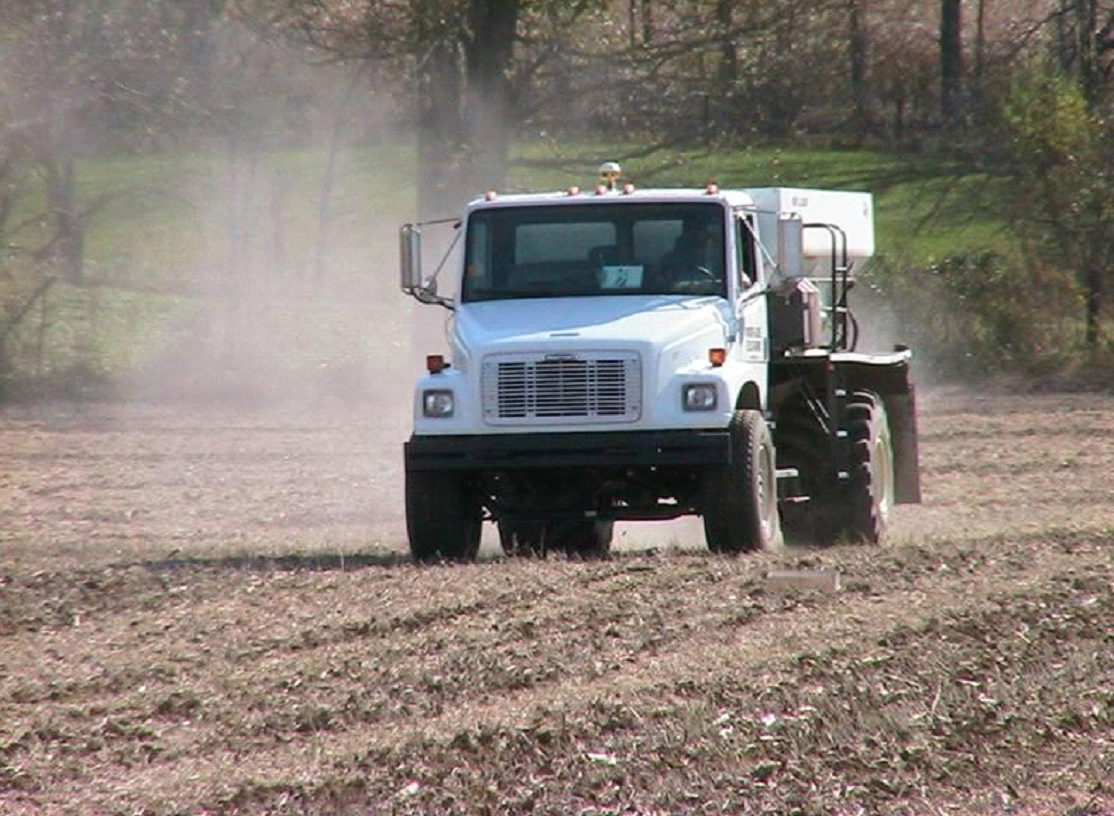 Lime application prior to soil preparation.
Lime application prior to soil preparation.Assessing soil fertility is the next step in gauging whether or not a site is suitable for alfalfa production. Alfalfa has a high fertility requirement and a soil test will determine the need for lime and fertilizer. Always apply the recommended quantities indicated on the soil test report. Proper fertilization and soil pH adjustment prior to establishment are critical to promoting early growth, disease resistance, and winter hardiness. Maintaining adequate fertility is equally important and is addressed in greater detail in the section titled “Fertilizing and Liming Established Stands”.
When soil analysis indicates a pH below 6.5, apply sufficient agricultural limestone to adjust the soil pH to 6.8 to 7.0. It takes time for lime to neutralize soil acidity, so it should be applied at least 6 months prior to seeding. If possible, the lime should be incorporated into the soil to allow the amendment to affect deeper portions of the soil. If more than two tons of limestone are needed, apply one-half of the amount and incorporate it by first disking and then turning the soil. Use a plow to uniformly mix the limestone in the plow depth. Apply the remainder and incorporate it into the soil surface by disking.
Phosphorous (P) and potassium (K) are two plant nutrients critical for establishing alfalfa stands. Adequate levels of P and K are crucial for root development and seedling vigor. Boron (B) and molybdenum (Mo) play significant roles in nodule formation and nitrogen-fixation and are essential for alfalfa establishment and production. Only small quantities of these micronutrients are needed. Immediately prior to planting, 1/4 oz of molybdenum (2/3 oz of sodium molybdate) should be applied to each bag (60 lbs.) of alfalfa seed in just enough water to slightly moisten the seed. (CAUTION: To avoid Toxicity, do NOT exceed the recommended amount of molybdenum.)
Alfalfa is a deep-rooting forage crop when unimpeded by soil properties. Fertilizer (particularly phosphorous) should be incorporated into the soil as deeply as possible using conventional equipment. Since alfalfa will survive for several years and fertilizer and lime applications made in subsequent years will be surface-applied, uniform incorporation before establishment provides long-term benefits.
Inoculation
Many companies have begun to market pre-inoculated alfalfa seed that have been coated with an inert material, usually lime, to protect the inoculant. This saves time and helps ensure adequate and appropriate inoculation. No further inoculation before planting should be necessary, unless the inoculated seed has been stored improperly or the inoculant has expired.
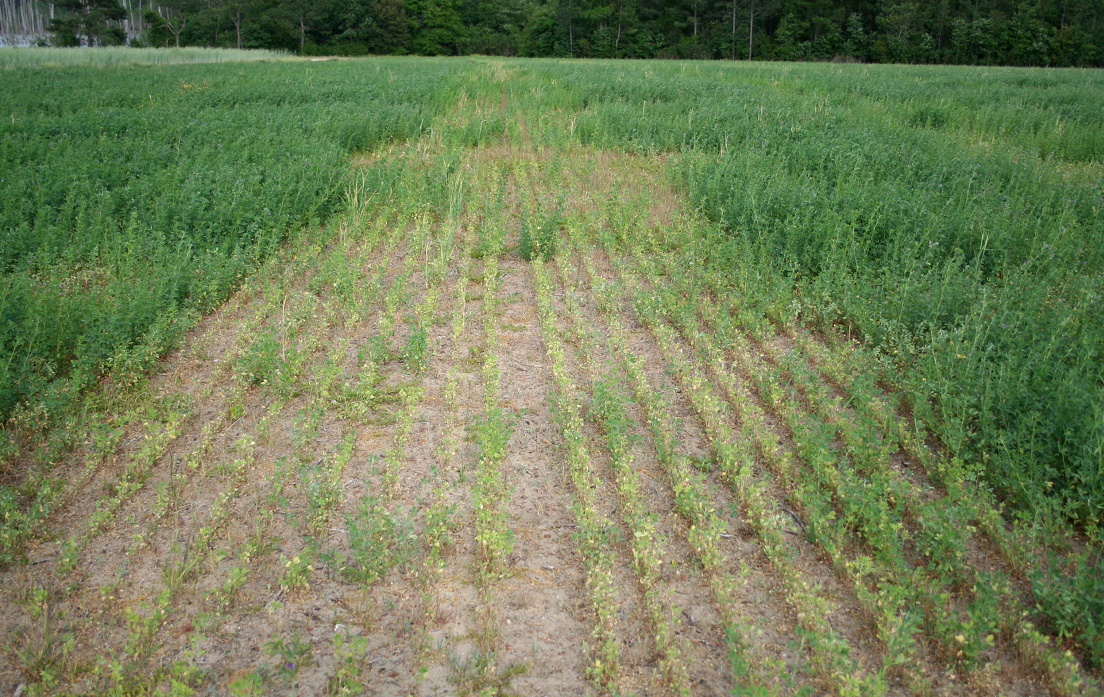 Improperly inoculating alfalfa seed will likely result in poor nodulation, Permanent stunting, or stand failure.
Improperly inoculating alfalfa seed will likely result in poor nodulation, Permanent stunting, or stand failure.If there is a question about the viability of the inoculum on pre-inoculated seed, re-inoculate the seed with fresh “Type A Inoculant” (the Rhizobium meliloti bacteria that are specific to alfalfa) just before seeding. Inoculants are usually packaged in plastic bags to protect the bacteria from drying. Protect bags of inoculant from direct sunlight or hot temperatures. One 8-oz bag of inoculant will generally be enough to inoculate one bag of seed. However, always read and follow the label instructions. Inoculate only the amount of seed that will be planted each day and keep the inoculated seed in a shady location until it’s placed into the planter.
To inoculate, fill a large metal or plastic tub about half full with seed and apply enough water to moisten the seed (you will need to stir the seed). Sprinkle the recommended amount of inoculant on the moist seed and stir until the seed are uniformly coated. Moist seed tend to stick together, so let the seed dry for a few minutes before seeding.
The inoculant sticks to the seed better if a water-sugar solution or syrup-water solution is used to moisten the seed. Research indicates that a commercial sticker material significantly improves inoculation.
Establishment Methods and Considerations
Prepared Seedbed: For monoculture alfalfa stands, plant alfalfa on a well-prepared, firm, weed-free seedbed. Plowing and disking should be done as needed, incorporating pre-plant applications of lime and fertilizer, and a good, firm seedbed should be ensured. All tillage or heavy disking operations should be completed at least 5 weeks before the expected seeding date. Smooth the seedbed and disk lightly as needed to control weeds and incorporate pre-emergence herbicides prior to seeding. Use of a heavy roller or culti-packer before seeding will firm the soil and improve seedling establishment and stands. A rule of thumb for determining when the soil is appropriately firm is observing the depth of footprints in the soil. When a boot-heel leaves only a 1/4-in. indention in the soil (assuming the person is of average weight), the soil is firm enough for planting.
Sandy Coastal Plain soils may have compacted layers or hardpans, which can restrict root growth and affect water and nutrient uptake by the plant. Subsoiling or chisel plowing can be beneficial if the soil has a hardpan.
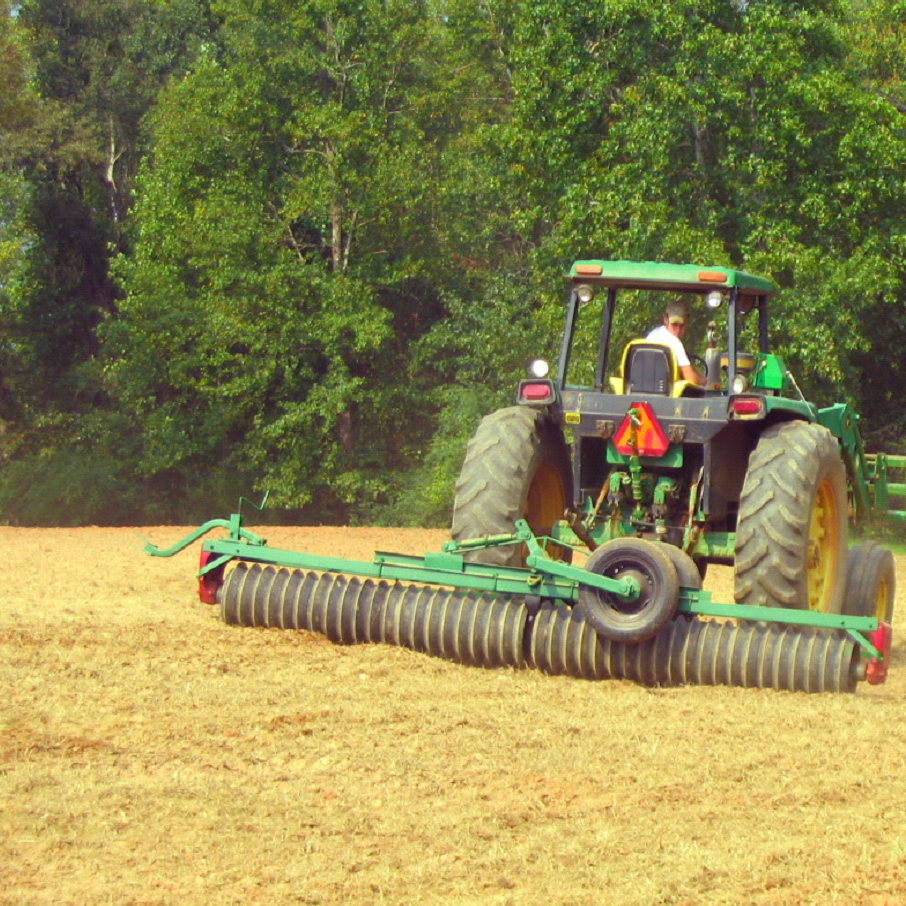 A cultipacker can help firm the soil prior to planting.
A cultipacker can help firm the soil prior to planting.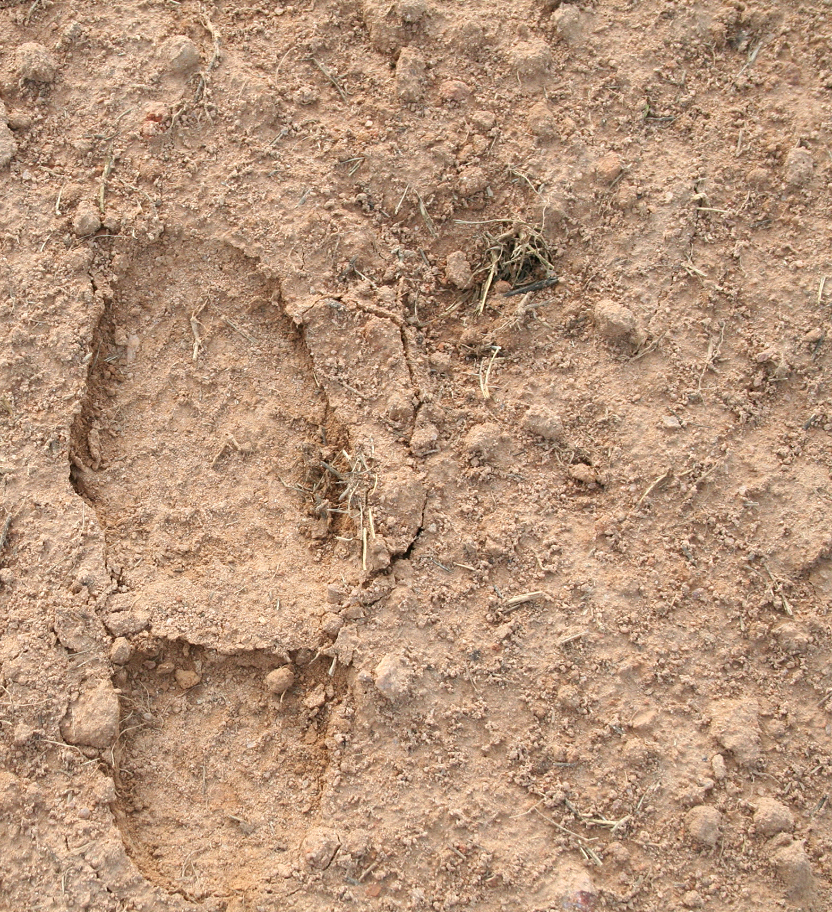 Soil that is firm enough for planting will allow a boot-heel to sink no deeper than 1/4-in.
Soil that is firm enough for planting will allow a boot-heel to sink no deeper than 1/4-in.No-Tillage Methods:
Although conventional tillage and planting into a prepared seedbed is ideal, planting alfalfa with a no-till (sod-seeding) drill can result in satisfactory stand establishment and yields. Some producers are planting alfalfa into existing stands of bermudagrass or other grass sods. This will require no-till establishment.
When planting alfalfa into a bermudagrass sod, ensure that the bermudagrass is dormant and closely mowed (and free of residue) or grazed. If the stand is to be primarily an alfalfa stand, use a row-spacing of 15 in. or less. If the stand is to managed as a mixture of bermudagrass and alfalfa with an expectation that it will eventually revert back to solid bermudagrass, use a row-spacing of 21 in. or more.
For no-till seeding into existing cool-season grass sods (e.g., tall fescue, orchardgrass), suppress the grass by closely mowing or grazing before planting with a no-till drill. If the grass is in or will be entering a rapid growth phase, chemical (herbicide) suppression of the grass immediately before planting may be necessary.
Seeding Methods and Rates: Using a cultipacking-seeder or grain drill with a small seed box to plant alfalfa into a prepared seedbed will usually result in satisfactory stands. Alternatively, seed may be broadcast and then incorporated using a double-gang, culti-packer. Regardless of the system used to plant the alfalfa, the seed should not be placed too deep (1/8- to 1/4-in. deep in loamy or clay loam soils; 1/4- to 1/2-in. deep in sandy loam or sandy soils). When seeding with grain drills, accurate depth control may be difficult to obtain. If seeding depth control will be difficult, the grain drill can be used as a broadcast seeder by disconnecting the drop tubes from the small seed attachment box and fixing it in such a way that the seed are discharged about 2 ft above the soil surface.
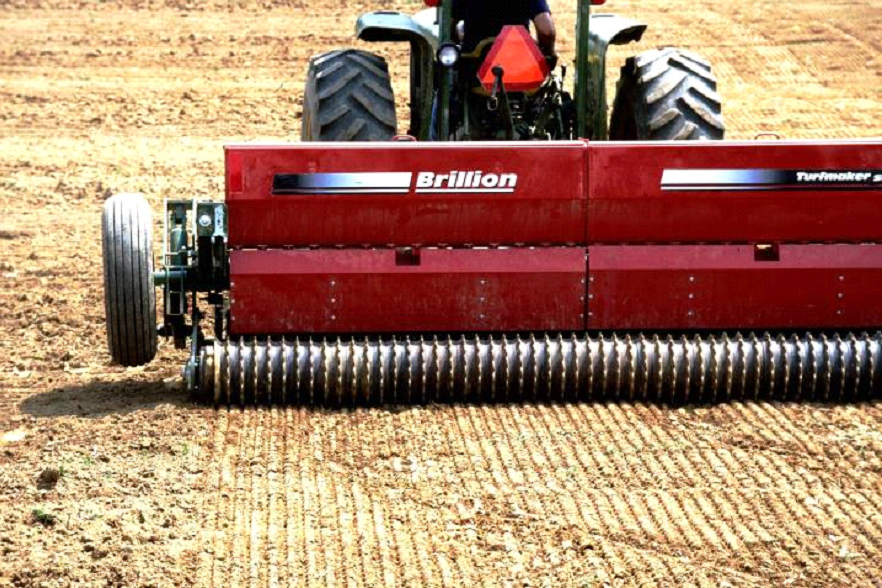 Cultipacking-seeder planting into a firm seedbed.
Cultipacking-seeder planting into a firm seedbed. Soil that is firm enough for planting will allow a boot-heel to sink no deeper than 1/4-in.
Soil that is firm enough for planting will allow a boot-heel to sink no deeper than 1/4-in.Cultipacking after planting with a grain drill will improve seed-soil contact.
Soil should be firm around the seed to provide proper seed-soil contact. Cultipacking or using a heavy corrugated roller after seeding will aid seed-soil contact and improve stands. An insecticide application after initial germination may be needed to control insects such as field crickets. If the seedbed is weedy (especially with ryegrass), spray with a non-selective, translocated herbicide (e.g., glyphosate) a day or two before seeding, or immediately after seeding.
When alfalfa is planted with a cultipacking-seeder or grain drill, the seeding rate should be 18 to 25 lbs. of pure live seed per acre. Higher rates should be used when seeding conditions are marginal, such as when planting with a no-till drill. When planting coated seed, some adjustment in seeding rate may be made to account for the coating weight.
Seeding Dates:
In the Limestone Valley/Mountains region and the upper half of the Piedmont, a fall seeding in mid-September to late October is recommended. In the lower two-thirds of the state (Lower Piedmont and Coastal Plain), a mid-October to late November seeding is recommended. Plantings made between early March and mid-April may be successful in both locations but will likely require irrigation and a very aggressive defense against weeds. When planting into cool- or warm-season perennial grass sods, do not plant in the spring.
Always plant alfalfa when soil temperature and moisture conditions will allow rapid seed germination and establishment. This is critical for later seedings. Alfalfa seedlings need 6 to 8 weeks of good growing conditions before the first hard freeze (temperatures below 25° F) occurs. Alfalfa seeds germinate much slower in cold soils and may benefit from a low application of N when the rhizobia are relatively inactive in cold soil.
Weed Control during Establishment: Weed competition can cause poor stands. Treatment with a pre-emergence herbicide, such as EPTC (Eptam) or benefin (Balan), that controls winter annual grass and broadleaf weeds is recommended. Common bermudagrass must be eliminated from the field before planting alfalfa. This grass is often extremely difficult to control in alfalfa stands. Further information about weed control during establishment and during the life of the stand are presented in the “Weed Control” section of this publication. Additional up-to-date information about specific herbicide options during alfalfa establishment can be found in the “Alfalfa Weed Control” section of the Georgia Pest Management Handbook.
Crop Rotation Requirement:
Alfalfa is an excellent addition to a crop rotation, particularly for crops that require high nitrogen fertilization. However, rotating out of alfalfa eventually must be done. Alfalfa produces compounds from its leaves and flowers that are autotoxic (i.e., they prevent alfalfa seed from germinating and growing). Once fully established (6 to 8 months), these autotoxic compounds prevent the “thickening-up” of a stand by planting more seed. This prevents alfalfa from being successfully planted into an existing or recently destroyed (within 8 to 12 months) alfalfa stand. Do not plant alfalfa into a field that contains or contained alfalfa within the last 8 to 12 months. Always allow a full growing season of another crop(s) before replanting alfalfa.
Fertilizing and Liming Established Stands
Maintaining adequate fertility is essential for successful alfalfa production, since nutrient deficiencies lead to yield losses, poor disease resistance, pest problems, and short-lived stands. If any nutrient is deficient, problems in any one or all of these areas can be expected. Thus, it is critical that a good soil fertility program be the basis of any alfalfa production system. This section briefly presents information on several aspects of soil fertility management.
Soil pH
It is critical that a soil pH of 6.5 to 7.0 be maintained in areas were alfalfa is grown. When soil pH is kept at this level, the nutrients stored in the soil will be most available to the alfalfa, and the alfalfa’s ability to use applied fertilizer nutrients will be improved. Maintaining the appropriate soil pH also promotes nodulation and more efficient nitrogen fixation. Soil test each fall and apply limestone as needed.
 Low soil pH in this area of an alfalfa field in South Georgia has resulted in a thin stand.
Low soil pH in this area of an alfalfa field in South Georgia has resulted in a thin stand.Maintaining proper soil pH also prevents toxic elements such as Al and manganese (Mn) from becoming soluble in the soil. When soil pH drops below 5.5, Al dissolves in the soil solution. Soluble Al is toxic to alfalfa roots and drastically inhibits root growth. Adding of lime raises soil pH, and the Al returns to a solid form.
Neutralizing soil acidity deep into the soil profile is difficult. As a result, the soil surface may be neutral while the subsoil is very acidic. In this situation, the addition of gypsum (CaSO4) may be helpful. Although gypsum does not alter the soil pH, it can infiltrate the soil profile and reduce the amount of soluble Al. Research with alfalfa has shown significant yield increases in response to gypsum application on some soils with acidic subsoils. A subsoil sample (soil from deeper than 15 in.) must be tested to determine whether gypsum is needed and if it will decrease toxic levels of Al.
Fertilization
Alfalfa has a high nutrient requirement, especially when the nutrients are removed from the field as hay or silage. For example, each ton of alfalfa hay may remove as much as 15 lbs. of phosphate (P2O5) and 60 lbs. of potash (K2O). Productive, high-yielding stands require that these nutrients be returned to the soil through fertilizer, manure, or other sources in order to maintain yields and persist. Thus, annual alfalfa field soil sampling and testing is critical for tracking soil fertility levels and nutrient needs. Soil samples should be taken at the same time each year. It is also recommended that the soil test information be supplemented with occasional plant tissue analyses (See the “Plant Analysis” section.)
Nitrogen:
In well-managed stands, the nitrogen-fixing bacteria that colonize nodules on the alfalfa roots will meet the crop’s nitrogen requirement. Nitrogen-deficient alfalfa is commonly a symptom of a soil pH that is too low. Soil pH markedly affects the activity of the rhizobia bacteria that fix nitrogen. Nitrogen deficiencies will also occur if the seed was not inoculated properly before planting or if, for some other reason, nodules have not developed. When this occurs in soils that have a pH of 6.5 to 7.0, the poor nitrogen fixation may be the result of other nutrient deficiencies such as boron, calcium, magnesium, molybdenum, etc.
To diagnose nitrogen deficiencies, dig up suspect plants and check the nodules. Active nodules, when cut in half, are dark pink or red in color. A brown, black, green, or pale pink color denotes an inactive nodule. Also, determine the soil pH and analyze the plant tissue for nitrogen. Nitrogen-deficient plants turn pale green with a slight yellowish tinge. Later, leaves may become distinctly yellow.
Phosphorous:
Phosphorus is an essential element for many vital alfalfa processes (e.g., root development, energy transfer, etc.). Soil phosphorous levels should be adjusted by fertilization prior to seeding and sufficient phosphorous should be applied in subsequent years to maintain adequate soil test levels. This element does not leach from the soil, so one application per year is sufficient.
Phosphorus levels in most of Georgia’s soils are naturally low. Phosphorus deficiency symptoms are not as well-defined as those of many other nutrients. In general, P-deficient alfalfa stands will be stunted, the leaves may be upward-tilting and much smaller than normal, and older leaves may be stunted and dark green or purple. Symptoms may also include a decreased growth rate, reduced nodulation, and delayed maturity. Phosphorus-deficient plants may appear grayish-green and resemble drought stress, even with adequate soil moisture.
Potassium (K):
For alfalfa, potassium is essential for high yields, persistent stands, and disease resistance. This element, which is second only to nitrogen in concentration in the plant, affects plant vigor, forage quality, winter survival, and stand life.
For most sites in Georgia, K deficiency will be the most common and most problematic issue. Potassium deficiencies in alfalfa are easily recognized. White spots appearing along the margins of older leaves are an early indication of K deficiency. In time, tissue between the spots turns yellow and dies. Since potassium is a mobile nutrient in plants, symptoms first appear on leaves that are lower in the canopy, and the severity of yellowing increases from the top to the bottom of the affected shoots.
Potassium deficiencies can be prevented and stand life prolonged by a good K fertilization program. Soil test K levels should be high or supplemented with K2O fertilizer when alfalfa is planted. Annual soil testing and recommended K fertilizer applications will be crucial to ensuring that this critically important nutrient is not deficient. Tissue analyses taken prior to early summer harvests will help verify that K levels in the plant are maintained at or slightly above sufficiency levels (1.8 to 2.0 percent).
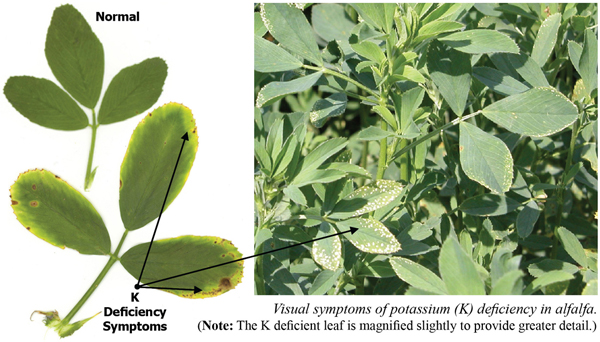
Multiple K applications will be more efficiently used by plants and will ensure that an adequate supply is available throughout the growing season. On heavy soils in the Piedmont and Mountain regions, two (spring and fall) or three (spring, summer, and fall) applications during the growing season are recommended. Sandy soils in the Coastal Plain do not hold K as well as the heavier soils in north Georgia. As a result, more frequent K applications are recommended. Four applications (late winter, early summer, late summer, and fall) should be sufficient. The fall application will ensure that the plants have adequate K for winter survival.
Sulfur:
Sulfur (S) is critical to protein formation, N-fixation, and maintaining root growth. Sulfur may become a limiting nutrient in plants like alfalfa that have high levels of nitrogen in their tissues. In Georgia, the need for S varies considerably. In the soil, S is held and released from organic matter and, once mineralized, can easily leach out of sandy soils.
Much of the S available to the plant results from atmospheric deposition of S being released during the burning of fossil fuels (coal, gas, diesel, etc.). Sulfur is absorbed through the roots as sulfate (SO4) or through the leaves as sulfur dioxide (SO2) gas. Another substantial source of S has historically been blended fertilizers that contained S as a by-product. Deficiencies of this nutrient have occurred more frequently in recent years because of a shift to the use of high-analysis phosphate fertilizers that contain only small quantities of sulfur and because of S removal from the emissions of coal- and lignite-burning electricity generation plants.
When alfalfa is grown on soils deficient in S, protein formation is retarded and upper leaves (including veins) turn light yellow. Growth is stunted and maturity is delayed as deficiencies become more severe. Leaves may become long and slender. Sulfur deficiencies are similar to nitrogen deficiencies except that with nitrogen deficiencies, the younger leaves turn yellow before the older leaves.
Sandy soils are more likely to be deficient in S than heavier soils. Sulfur may be deficient on soils that contain little organic matter or where such factors as cool soil temperatures, drought, or low pH cause slow decomposition of organic matter. If these conditions exist or S deficiency is suspected, a tissue analysis can assess S levels. If needed, applying 10 to 30 lb of S per year should be adequate for alfalfa.
Boron:
Alfalfa needs very small quantities of boron (B), but a severe deficiency of this nutrient can cause yield reductions of more than two tons of dry matter per acre. If soil B levels are inadequate, deficiencies may appear. Symptoms of B deficiency appear first at the shoot tips (terminal portion of shoots) where rapid growth is occurring. The leaves turn yellow and sometimes red at the tips, while the lower leaves remain green. Retarded growth at the shoot tips causes growth at buds located lower on the shoot. This growth pattern causes the plant to exhibit a rosette appearance.
Boron deficiency in alfalfa may be prevented by applying boron to the soil. An annual application of B (three lbs. of B per acre) is recommended and should be applied with other fertilizer materials as a topdressing in the late winter. Boron may also be applied as a foliar spray using a soluble source of B such as Solubor (20.5 percent B) in 25 to 30 gallons of water per acre. Do not apply more than 1/2- to one lb. of B per acre as a foliar spray. Higher rates can cause leaf burn.
Molybdenum:
Molybdenum (Mo) is required for adequate nodulation and nitrogen fixation. Deficiencies are frequently observed on acid soils because Mo becomes less available as the soil pH decreases. Deficiency symptoms are similar to those of nitrogen deficiency. Growth is reduced and plants turn a pale yellow. Lower leaves may die and drop prematurely. Molybdenum is the only plant-essential micronutrient that becomes increasingly available as soil pH is raised by liming. To prevent Mo deficiency, lime the soil to increase pH to recommended ranges. An application of Mo (8 oz of sodium molybdate in 25 gallons of water per acre is recommended) should be made every other year in the spring when alfalfa is 6 to 8 in. tall.
Calcium:
Calcium (Ca) deficiencies are rare under field conditions if soil pH is above 6.0. Compared with grasses, Ca levels in alfalfa are relatively high. Older leaves contain a higher percentage of the element than younger ones. Calcium deficiency results in leaves that are distorted at the growing points and shoot tips that wither and die. If limestone is applied to correct soil pH before planting and if soil test recommendations are followed in succeeding years, Ca deficiencies are unlikely.
Magnesium:
Magnesium (Mg) deficiency is most likely to occur on acid, sandy soils low in Mg. Magnesium deficiency causes yellowing between the veins of leaves and generally is first observed in older leaves. Use of dolomitic limestone as the liming material will increase soil magnesium and reduce the possibility of deficiencies. In fields with an optimum or high soil pH and low soil Mg, apply 25 to 50 lbs. of Mg per acre. Sulfate of potash-magnesia contains 22 percent K2O, 22 percent S, and 11 percent Mg, and is a good material for soil applications of Mg, as well as K and S. An Mg deficiency could be confused with iron deficiency in plants, except that iron deficiency is first observed in newer leaves.
Manganese:
Most soils with a pH of 6.5 to 7.0 supply adequate manganese (Mn) for alfalfa. As a result, Mn deficiencies are rare in alfalfa, except when a stand is subjected to poor drainage. This may occur in depressions in the field where the soil pH may be higher than in surrounding areas. Applying 10 to 15 lbs. of Mn per acre on mineral soils will usually correct known deficiencies. Foliar applications will be required if the deficiency is severe. Leaves of Mn deficient plants exhibit a mottled yellowing between the veins similar to iron or Mg deficiencies, but the veins never turn yellow.
Zinc:
Most soils contain adequate zinc (Zn) for alfalfa production. Deficiencies are more likely to occur on the more weathered, coarse-textured soils in the Coastal Plain. Soil test to determine the Zn level in the soil and apply three lbs. of elemental Zn per acre if the soil level is low. Zinc deficiencies may cause abnormal root tips and dwarfed vegetative growth. Bronze spots that later become white and necrotic may appear around the leaf margin. Moderate Zn stress in alfalfa may be difficult to recognize because symptoms appear erratically and growth is only moderately stunted.
Detecting Deficiencies
Nutrient deficiencies may be caused by several factors, including a lack of nutrients in the soil or a lack of nutrient uptake due to restricted root absorption. Deficiency symptoms may also occur even though the plant is able to absorb the nutrients. This results when transport or utilization of the nutrient within the plant is blocked.
Remember: At least 16 nutrient elements are essential for healthy plant growth, but a deficiency of only one of these can negatively affect plant growth. Nutrient deficiencies may show up in one of several ways: Some alfalfa fields may not show any change in appearance even though deficiencies are present; some may only have reduced yields; and still others may have both visible deficiency symptoms and reduced yields. It is better to prevent nutrient deficiencies through a balanced, proactive fertility program than to correct deficiencies once symptoms appear.
Plant Analysis
Annual soil sampling and testing provides the basis for the soil fertility program. However, it is also recommended that the soil test information be supplemented with occasional plant tissue analyses. Tissue samples should be obtained from alfalfa fields in late June or early July within 1 to 2 weeks of a harvest. Analyzing samples at the time of the growing season can help assess macro- and micro-nutrient levels and identify potential deficiencies in time to correct them before they have lasting effects. In severe cases of nutrient deficiency, plant analysis should only be viewed as a diagnostic aid.
Sampling Procedures:
Samples should be obtained by clipping the top 6 in. of growth prior to or at 1/10 bloom stage (i.e., when 10 percent of the shoots have one or more flowers). Obtain clippings in this way from 40 to 50 areas in the field or from each management zone. Combine the clipped material into one sample and air-dry for one-half day. Do not put fresh plant tissue into polyethylene or tightly-sealed paper envelopes. Moisture loss from plants in tightly-sealed containers will transfer nutrients out of the plants and distort the analytical results of the plant tissue. If a plant analysis kit is not available, an ordinary paper bag or envelope is a suitable container. The sample should be relatively free of dust and soil particles. Wash the fresh tissue gently with clean tap water and a clean rag or sponge and blot dry. Plants that are diseased, damaged by insects, or under moisture stress should not be sampled for plant analysis. Dead plant tissue should not be collected with a sample or used for diagnostic purposes.
The University of Georgia has an excellent plant analysis service. Information and plant analysis mailing kits are available from your county Extension office.
Irrigation Management
Alfalfa uses a substantial amount of water to produce high yields. Fortunately, alfalfa is exceptionally deep rooted and can access water stored deep in the soil profile. However, very few sites will have soils that are capable of holding and providing the amount of water necessary to maximize alfalfa production, unless the crop is irrigated or consistently receives adequate rainfall.
Evapotranspiration (ET), or the amount of water that evaporates from plant surfaces and the soil, is affected by many weather-related variables such as temperature and relative humidity, and by the growth rate/maturity of the plant. In Georgia, ET rates during the summer generally are 0.20 to 0.25 in. of water per acre per day. This means that alfalfa may use 1 acre-inch of water every 4 to 5 days at peak demand. Despite relatively high precipitation rates, irrigation will be needed to supplement rainfall during the summer in most cases.
Yield losses in alfalfa may occur when soil moisture content drops below 50 percent of the soil’s available water-holding capacity. This yield loss cannot be recovered by additional irrigation after the damage has been done. Therefore, it is important to maintain soil moisture above this level.
To prevent unnecessary irrigation, alfalfa producers should schedule their irrigation. Irrigation scheduling can be accomplished by estimating soil moisture using the water balance method, wherein water inputs (rain or irrigation) are balanced against water outputs (the ET demand).
The number of factors that must be considered when scheduling irrigation using the water balance method can result in substantial errors when too many “guesstimates” and bad assumptions are made. Therefore, it is critical to use irrigation scheduling calculators, the best available weather data and ET estimates (e.g., from www.georgiaweather.net), and routine checks of actual field conditions using a soil probe or shovel. Additionally, soil moisture can be directly measured by properly installing and calibrating soil moisture monitoring devices in representative locations within the field. More information about developing an irrigation scheduling system for alfalfa or other crops can be found at the University of Georgia’s Stripling Irrigation Research Park website https://striplingpark.caes.uga.edu/.
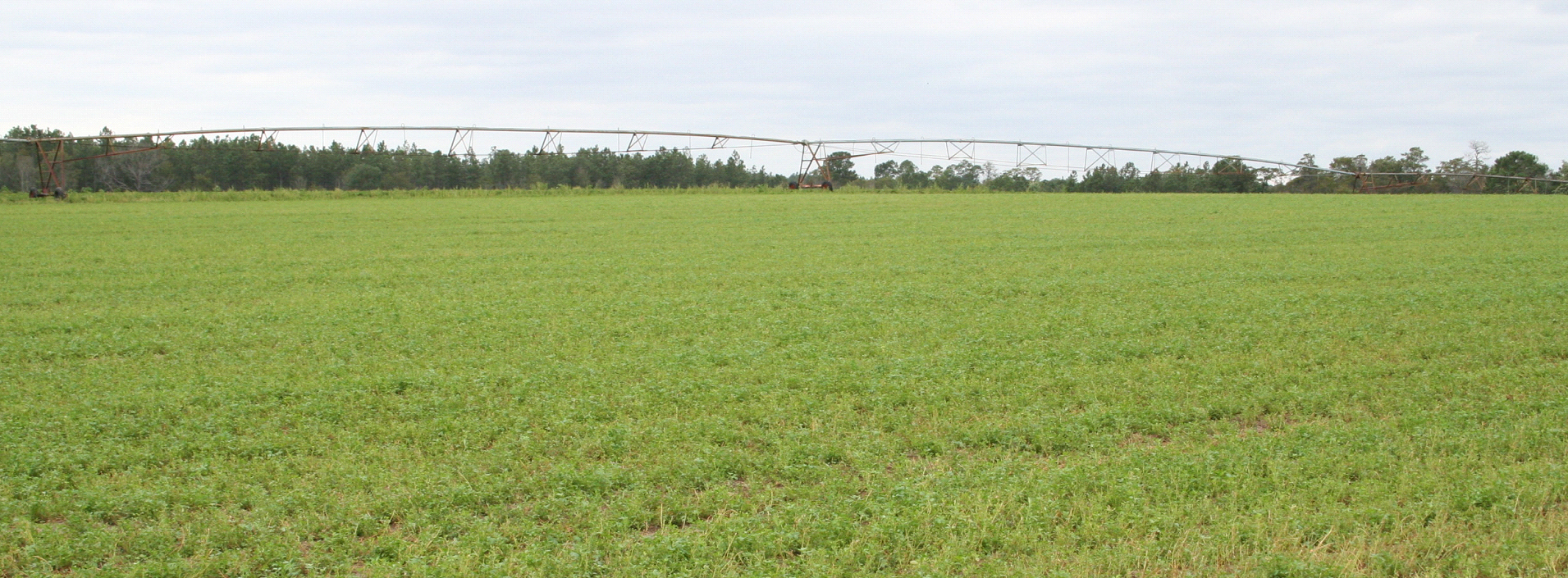 A center pivot irrigation system sits ready to irrigate one-week-old regrowth on an alfalfa field in Coffee County, GA
A center pivot irrigation system sits ready to irrigate one-week-old regrowth on an alfalfa field in Coffee County, GAIrrigation practices also must factor in the timing of alfalfa harvests, especially if the crop is to be dried for hay. Excess soil moisture will severely delay curing rates of hay crops. Wet soils may also lead to substantial damage and soil compaction from heavy machinery operations or hoof traffic. For heavy-textured, clay-type soils, do not irrigate for at least 4 to 5 days prior to cutting the alfalfa hay. In lighter-textured, sandy soil types, this interval may only need to be 2 to 3 days. Irrigation (as required) should begin again as soon as possible after harvest. If moisture stress occurs during early regrowth, severe yield losses can occur.
Harvest Management
Alfalfa can produce high yields of high-quality forage for several years. However, the yield, quality, and persistence of alfalfa are all highly dependent upon several harvest management factors.
Harvest Timing Affects Yield, Quality, and Persistence
Harvest management of alfalfa requires the manager to balance yield, quality, and persistence. Maximum forage yield in alfalfa will occur at about the time the plant reaches the full-flower maturity stage (Figure 1). However, this is NOT the ideal stage for cutting alfalfa because forage quality declines as the plant matures. One reason for this is that the more highly-digestible leaf material makes up less of the total yield. Secondly, as alfalfa matures, the forage becomes more fibrous and harder to digest (Table 2).
 Figure 1. The relative effect of advancing alfalfa maturity stages on total digestible nutrients (TDN) and leaf, stem, and total yield.
Figure 1. The relative effect of advancing alfalfa maturity stages on total digestible nutrients (TDN) and leaf, stem, and total yield.When to Harvest:
Alfalfa should be harvested at the early bloom/flower stage of growth (when 10 percent of plants have flowers). Harvesting at this growth stage represents the best compromise between forage yield, forage quality, and maintaining healthy stands. After the first cutting is taken, alfalfa will usually reach the early bloom stage every 28 to 35 days. The first cutting depends on weather and the variety’s dormancy rating. In general, alfalfa growers in south Georgia may be able to make their first cutting in early April, while it may be as late as mid-May before the first cutting occurs in the north Georgia Mountains. Because of the differences in the length of growing season, alfalfa is usually cut five to seven times per year in south Georgia but only four to five times per year in north Georgia. In the seedling year, the first cutting likely will be delayed about 1 month behind older-growth stands.
| Table 2. Expected range in forage quality† for alfalfa at various maturity stages.‡ | |||||
| Stage of Maturity | CP | NDF | ADF | TDN | RFQ |
| Vegetative | 24-27 | 25-37 | 20-27 | 68-75 | 230-300 |
| Bud | 22-26 | 38-47 | 28-32 | 64-67 | 160-250 |
| Early bloom | 18-22 | 42-50 | 32-36 | 61-64 | 125-180 |
| Mid-bloom | 14-18 | 46-55 | 36-40 | 58-61 | 100-150 |
| Late bloom | 9-13 | 56-60 | 41-43 | 50-57 | 90-110 |
| † Alfalfa will often be higher in fiber concentration, less digestible, and have lower relative forage quality when subjected to higher temperatures or soil moisture stress. Abbreviations: CP = crude protein; NDF = neutral detergent fiber; ADF = acid detergent fiber; TDN = total digestible nutrients; RFQ = relative forage quality. ‡Adapted from Ball et al, 2007. Southern Forages, 4th Edition. |
|||||
Exceptions to harvesting at the early bloom growth stage:
- The first cutting of a stand that was planted the previous fall should not be taken until the plants are in the mid-bloom stage (25 percent of plants have flowers). This will allow the root system and crown to be more fully developed and will prevent excessive losses early in the stand’s life. If the root system and crown were well developed prior to the onset of winter, cutting at the early bloom stage will be acceptable.
- The first harvest in spring can be made from mature stands at the bud growth stage (just before flowers appear) without negatively affecting the stand. Do NOT harvest at the bud stage when the stand was planted the previous fall.
- During late summer (July and August) in south Georgia, delay one harvest until the mid-to-late bloom stage (25 to 50 percent of plants have flowers). Delaying harvest will allow the plants to fully rebuild root carbohydrate reserves. Growing conditions are usually very stressful during this period, and a delayed harvest can be made with little effect on annual yield of digestible nutrients.
 Figure 2. The relative effect of advancing alfalfa maturity on the root reserves when alfalfa is harvested at early bloom or bud stage.
Figure 2. The relative effect of advancing alfalfa maturity on the root reserves when alfalfa is harvested at early bloom or bud stage.The Effect of Harvesting Too Soon:
Alfalfa plants store carbohydrates, protein, and other nutrient reserves in the crown and upper part of the tap root (Figure 2). Carbohydrate and protein reserves are required by the plant for rapid regrowth after it has been harvested. The plant mobilizes these reserves and will continue to live off of these nutrients until enough leaf area is created to sustain the plant’s growth. As a plant matures, it replenishes these nutrient reserves in preparation for the next regrowth. This cycle is repeated each time the crop is cut.
Cutting too early, before root carbohydrate reserves are replenished, will result in alfalfa that has not built up enough root reserves to support vigorous regrowth. If the alfalfa is continually harvested before the bud stage and continually unable to replenish the root reserves, the plants may fail to initiate regrowth or over-winter and the stand will be reduced.
Harvesting too soon is most damaging to the crop during the hottest part of the summer. When under heat stress (particularly when nighttime temperatures are in excess of 80° F), alfalfa does not efficiently produce and store carbohydrates. This is the primary reason why delaying at least one harvest during this period can improve stand vigor.
Regrowth after Harvest
Regrowth after harvest may occur from two sites. The first site is at the crown buds, which elongate and form new shoots. Usually, some crown buds will start to grow and may be 1 to 2 in. tall before the crop is ready to harvest. If they are not clipped when the crop is harvested, regrowth will be very rapid. This is the reason a cutting height 2 to 4 in. above the soil surface is recommended. The second site for regrowth is the axillary buds on the lower portion (below the cutting height) of stems that were harvested. Unless the mowing height is too low, these buds can provide significant regrowth.
It is critical to get alfalfa that is cut for hay cured and removed promptly. Alfalfa hay that fails to cure within 4 to 6 days of cutting may slow the rate of regrowth. Similarly, alfalfa should be irrigated (as required) as soon as possible after the previous crop has been removed. Moist soil conditions at the initiation of regrowth helps to determine the number of shoots per square foot — a key component of alfalfa yield.
When to Make the Last Harvest in the Fall
Because Georgia does not normally experience the same severe winters and long-term snow cover as other alfalfa-producing regions, there is more flexibility in fall management programs. However, some considerations differ substantially between north and south Georgia.
North Georgia:
Winters in the Limestone Valley, Mountains, and Piedmont regions can be relatively cold, and low temperatures occur earlier in the fall than in south Georgia. Varieties in dormancy groups 4, 5, and 6 will usually not go completely dormant (except at higher altitudes in the mountains) in north Georgia. However, the frequent low temperatures greatly restrict alfalfa growth in the winter and early cold snaps can greatly impact root reserves prior to the onset of winter.
Fall management for alfalfa in north Georgia is critical and should be done in a way that allows the plant to store enough root reserves to survive the winter. In general, this is done by not harvesting after late September in the Mountains or early October in the Piedmont.
A final “freeze-down” harvest can be made after plant tops have been killed by temperatures of 25° F or lower. Since forage quality deteriorates rapidly after freezing, harvest within 2 weeks of plants freezing. Evidences of freezing are yellowing, browning, and curling of leaves and permanent wilting.
Harvesting residue after a killing frost can be beneficial for preventing insect and disease problems in the spring. Alfalfa weevil eggs are deposited in stems during the late fall and many will be removed by a freeze-down harvest, reducing alfalfa weevil populations and damage in the spring. Removing this residue also tends to reduce the severity of some cool-season foliar and stem diseases that affect the spring regrowth.
South Georgia:
Most alfalfa varieties grown in the Coastal Plain are in dormancy groups 7 and 8, with some 9s along the Florida border. These cultivars will usually maintain active growth well into late November or early December, slow (but not go completely dormant) in January and February, and initiate regrowth in mid-February or early March. Cold temperatures (less than 25° F) will kill back top growth but regrowth occurs from the crown with the return of warmer weather. Frequently, only the taller stems will be frozen. Temperatures are usually warmer near the soil surface and shorter growth is not severely damaged.
Going into the winter with a high level of root reserves is a good idea. Schedule the last harvest to allow about 30 days of regrowth before temperatures below 25° F are expected. As a rule of thumb, targeting between November 1 and 15 as the cut-off date for the post-freeze harvest works well.
Curing and Producing High-Quality Alfalfa Hay
Producing high-quality alfalfa hay requires excellent management, especially since hay production in Georgia is often a race against the weather. In addition to cutting the crop at the correct stage of growth, it is important to utilize tools that lessen the time it takes to dry the forage. These tools also must be used in ways that minimize the loss of the high-quality leaves.
Cutting Method:
Strategies for drying alfalfa begin with the harvest implement. Alfalfa harvested for hay should be cut with a mower-conditioner, which usually allows the forage to dry 20 to 30 percent faster than when no conditioning is used (Table 3). The effect on drying rate is greatest during the first 1 to 2 days after the forage is cut. To maximize drying on the day of cutting, alfalfa to be cured for hay should be cut as soon as the dew is off in the morning.
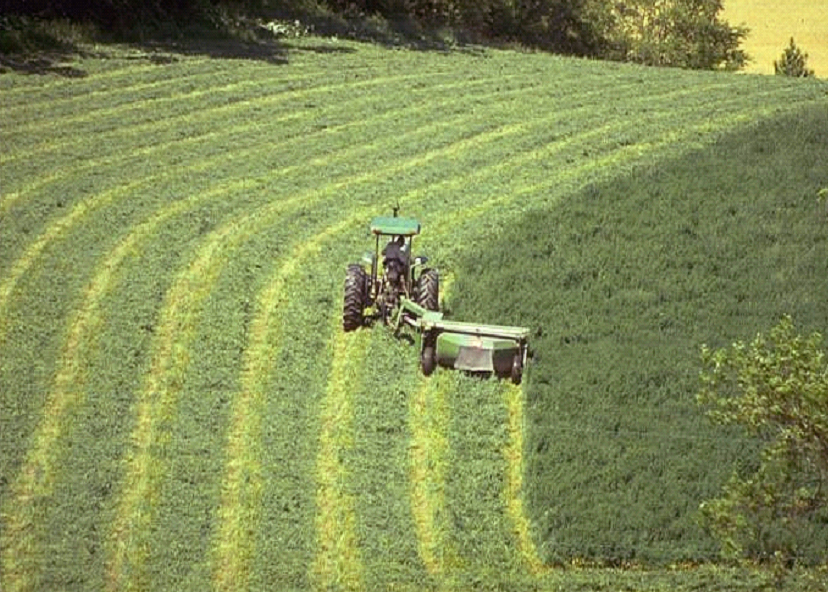 A mower-conditioner cutting alfalfa.
A mower-conditioner cutting alfalfa. Figure 3. The effect of conditioning treatment (disc-mower with no conditioner, rubber crimping roller-, steel flail-, or plastic flail-type conditioner) on average yield losses, as a percent of the total yield.*
Figure 3. The effect of conditioning treatment (disc-mower with no conditioner, rubber crimping roller-, steel flail-, or plastic flail-type conditioner) on average yield losses, as a percent of the total yield.*Adapted from Borreani et al., 1999. Agron. J. 91:457–463.
| Table 3. The average relative drying rate of alfalfa during the first 2 days after cutting if it was subjected to a rubber crimping roll-, steel flail-, or plastic flail-type conditioner and subsequently tedded or allowed to dry without tedding.* | ||
| Relative Drying Rate | ||
| Not-Tedded | Tedded | |
| — difference from control— | ||
| No conditioner | ** | +17% |
| Rubber crimping roll | +18% | +48% |
| Steel flail | +24% | +50% |
| Plastic V-flail | +14% | +35% |
| * Adapted from Borreani et al., 1999. Agron. J. 91:457–463. ** The changes in drying rates are set relative to the control treatment (no conditioner, not-tedded). |
||
For alfalfa, it is best to use a mower-conditioner that presses and crimps the forage between two inter-meshing, chevron-shaped rollers. These crimping rollers crush the stems and allow the drying rate of the stem to more closely match the faster-drying rate of the leaves. This creates more uniformity in the drying rate of the forage, which helps to reduce leaf losses during other hay curing steps.
The most common mower-conditioner in Georgia is the steel flail-type conditioner, which uses V-shaped flails to help strip away some of the waxy coating from the plant material as the forage is being harvested. Although this works well for fine-stemmed grass crops, flail-type conditioners can cause significant leaf losses that lower yield and crop quality (Figure 3).
What is the Right Time of Day to Cut Alfalfa?
The time of day when alfalfa is cut may seem unimportant, but it has significant implications for drying time and, in some cases, forage quality. Therefore, for Georgia conditions, it is recommended that alfalfa be cut early in the day (as soon as the dew is off). Three key facts need to be considered to understand this recommendation:
- Respiration by the plant (and any microbes acting on the plant) will continue to use sugars and other carbohydrates until the plant moisture drops below 48 percent.
- Moisture loss from the plant occurs primarily via open stomata (tiny holes in the leaf that allow moisture, O2, and CO2 exchange with the surrounding air), even after the plant is cut.
- Alfalfa stomata are open during the day and close at night or when they are excessively shaded.
- Because of respiration losses, it is critical to dry the alfalfa crop down to below 48 percent moisture as soon as possible. If alfalfa is cut during the morning, the stomata will be open and the crop will lose moisture faster than if the crop is cut late in the day or at night. This rapid moisture loss will be even greater if the swath is laid out as wide as possible to maximize surface area and to minimize shading (which will cause stomata to shut). If the crop is cut in the morning and the forage is spread out, alfalfa may actually drop below the 48 percent moisture level by the end of the first day or early on the following day.
Since the later drying phase (from 48 percent down to 16 to 18 percent moisture) can be rather slow, anything that can allow the crop to enter into the last phase of drying sooner will help the crop dry out more quickly. Cutting alfalfa early in the morning will take full advantage of alfalfa’s physiology to get it to dry. Catching several days in a row that grant good drying weather in Georgia is generally rare. Consequently, any drying advantage that can be gained should be taken.
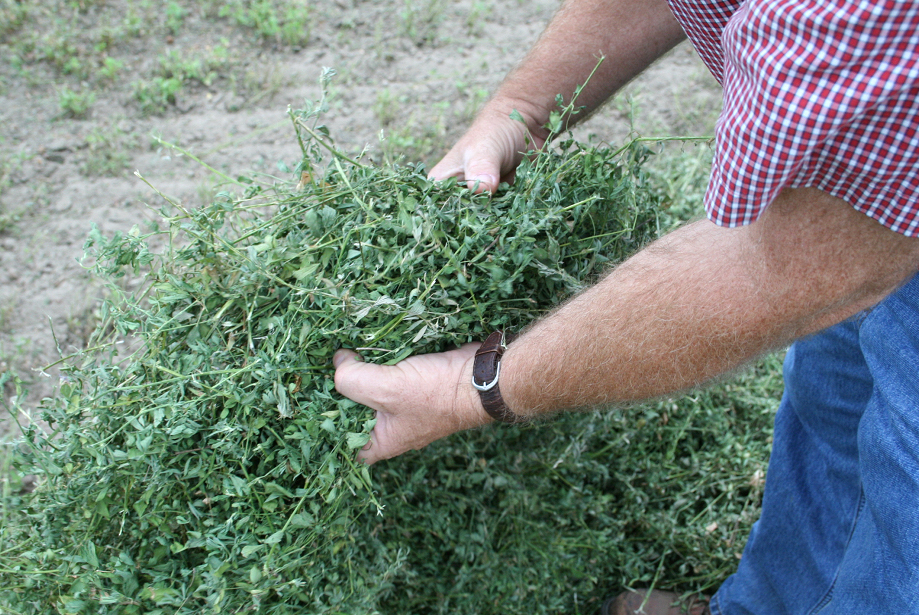 Tedding must be done carefully, otherwise the high-quality leaves may be knocked off and yields and quality will suffer.
Tedding must be done carefully, otherwise the high-quality leaves may be knocked off and yields and quality will suffer.Tedding:
The process of tedding (turning and fluffing the forage) greatly accelerates the drying rate of alfalfa, especially when used in combination with a mower-conditioner (Table 3). However, tedders can cause leaf loss if the crop is too dry. Therefore, it is important to appropriately time the use of the tedder and prevent excessive quality losses. Usually, it is best to ted alfalfa hay in the morning the day after the forage is cut. When tedded at this time, the forage will still be relatively moist (greater than 50 percent moisture) and tedding should have a minimal effect on leaf loss. Additional teddings may be useful; however, care should always be taken to minimize leaf losses retain forage quality. This risk is best minimized when tedding operations are performed in the morning and completed before or soon after the dew is off.
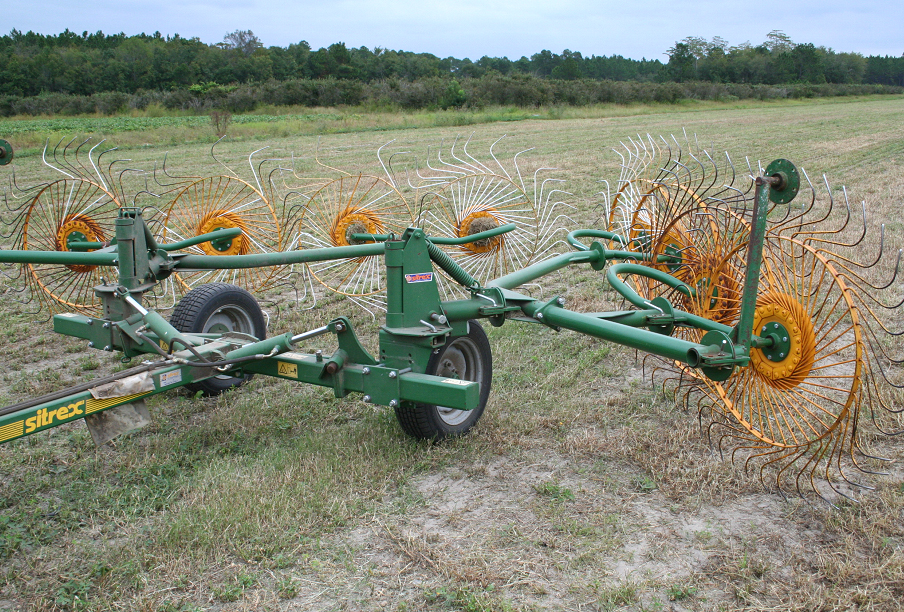 A wheel rake parked at the edge of an alfalfa field in Coffee County, GA after the hay has been harvested.
A wheel rake parked at the edge of an alfalfa field in Coffee County, GA after the hay has been harvested.Raking:
Raking accumulates the forage swaths into windrows for baling. Like tedding, raking operations can cause excessive leaf losses if they are improperly timed. For alfalfa, it is critical to rake when the forage is at approximately 40 percent moisture. The curing process will be completed in the windrow and the crop will retain more leaves than if it is raked dry. If the hay becomes too dry before windrowing, excessive shattering of leaves will occur. Under these conditions, rake at night or early in the morning when the leaves have absorbed moisture from the air. Parallel-bar rakes usually result in less damage to the crop than wheel rakes, but must be operated at a relatively slow ground speed.
Baling:
Baling packages the hay in a transportable form; however, bales must be sufficiently dry before they are formed. Baling when the moisture is too high will increase mold growth, reduce quality, and cause excessive heating or even spontaneous combustion.
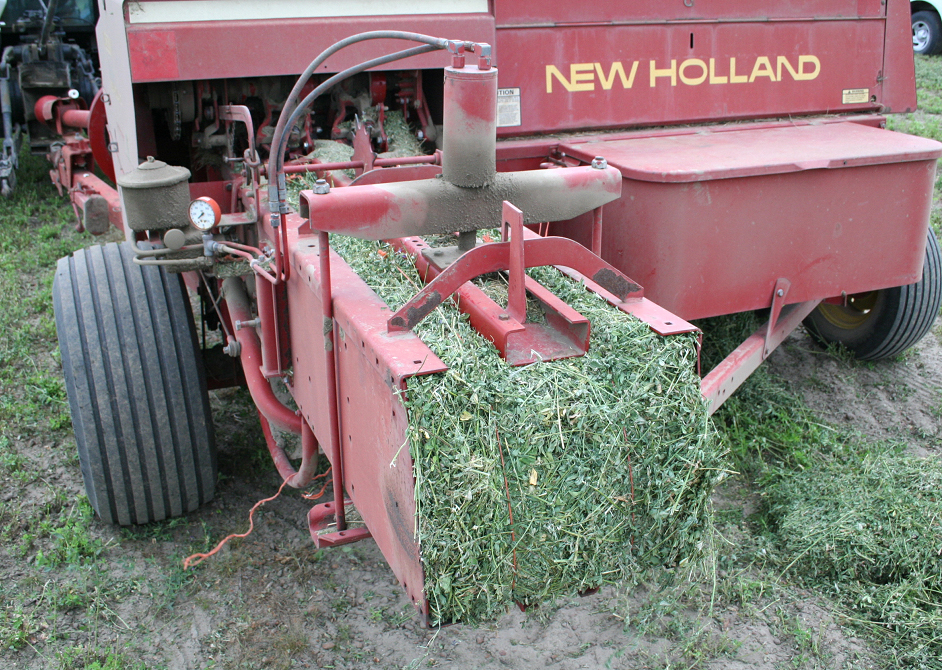 A square baler baling alfalfa in a field in Coffee County, GA
A square baler baling alfalfa in a field in Coffee County, GA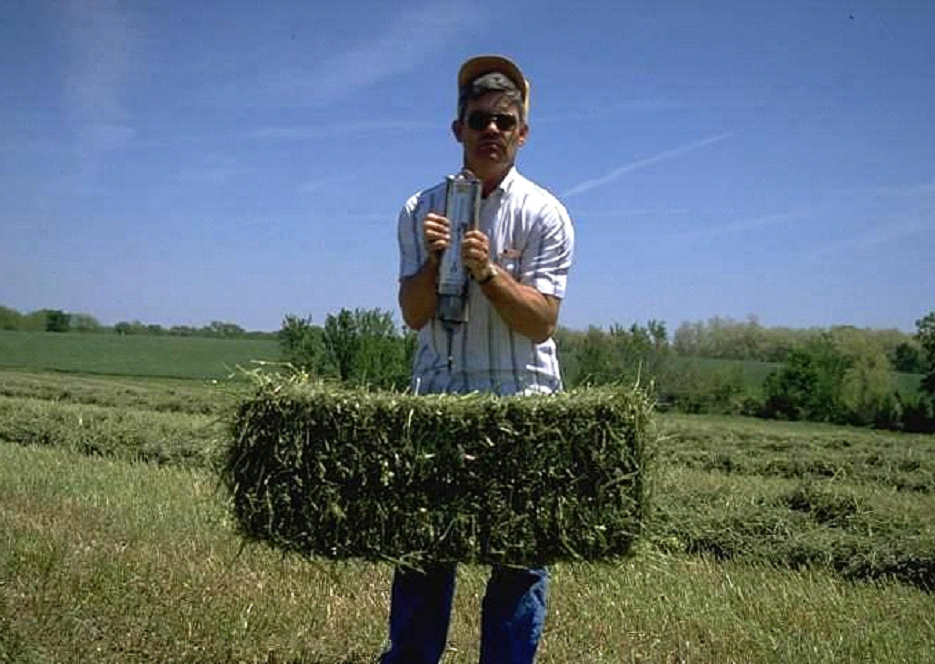 Weight square bales in the field with a calf scale to ensure they are hitting the target weight for your market.
Weight square bales in the field with a calf scale to ensure they are hitting the target weight for your market.Most alfalfa hay in Georgia is baled in small rectangular (“square”) bales. Square bales of alfalfa are typically more acceptable in the commercial hay market because of their lighter weight (usually less than 75 lbs.) and ease of handling in small lots. Small square bale systems can be more labor intensive than the larger package hay systems, though numerous labor-saving devices exist for handling, loading, and unloading small bales. Square bales usually are less dense than larger bale systems. As a result, they can be baled at slightly higher moistures than the large bale systems. Even so, to prevent excessive heating during storage, alfalfa should not be baled in small squares until the crop has dried to a moisture content of 18 percent or less.
Large round balers that produce cylindrical bales are commonplace in Georgia grass hay operations. These balers can also be used to bale alfalfa. However, the major disadvantage to these bales is that their marketing options are more limited. Also, these bales should not be formed until the forage moisture is less than 15 percent, since these bales are dense and less able to allow moisture and heat to diffuse from the forage once the bale is formed.
Similarly, alfalfa may also be baled in large rectangular bales. These bales are usually as dense as the large round bales. As a result, alfalfa should be less than 15 percent moisture when large rectangular balers are used. Handling and marketing problems are comparable to those of the large round bales.
Hay Preservatives:
Alfalfa can be baled at higher moisture levels (20 to 25 percent) when a hay preservative is used. Fewer leaves will be lost from shattering during baling operations at 20 to 25 percent moisture than at 15 to 18 percent moisture. Hay preservatives are usually sprayed or spread on the windrow via an applicator mounted on the baler. When the preservatives are applied according to manufacturer recommendations, treated hay is safe to feed to all livestock.
There are three general types of hay preservatives: organic acids, ammonia and ammonia-based products, and microbial additives. The use of propionic acid has been proven effective. Newer formulations contain buffering solutions that minimize the corrosive effect that these chemicals have on equipment. Ammonia and ammonia-based preservatives are generally used on lower-quality forage crops to obtain a crude protein increase and are not economically feasible for alfalfa. Many microbial products have been promoted recently for use as hay preservatives, but the effectiveness of these products under conditions in Georgia remain relatively unknown and are therefore not recommended.
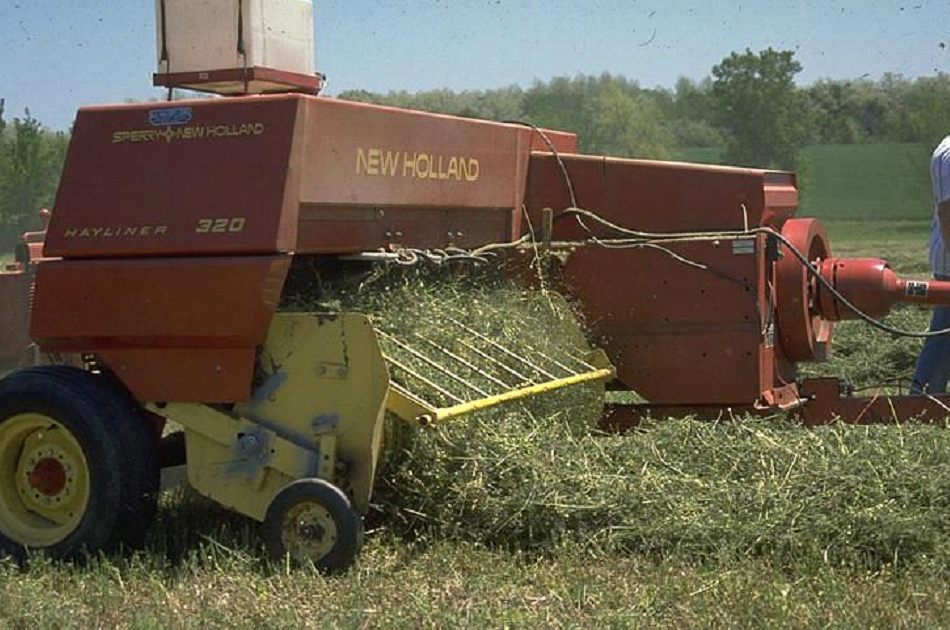 Hay preservative being applied to alfalfa hay as it is being baled.
Hay preservative being applied to alfalfa hay as it is being baled.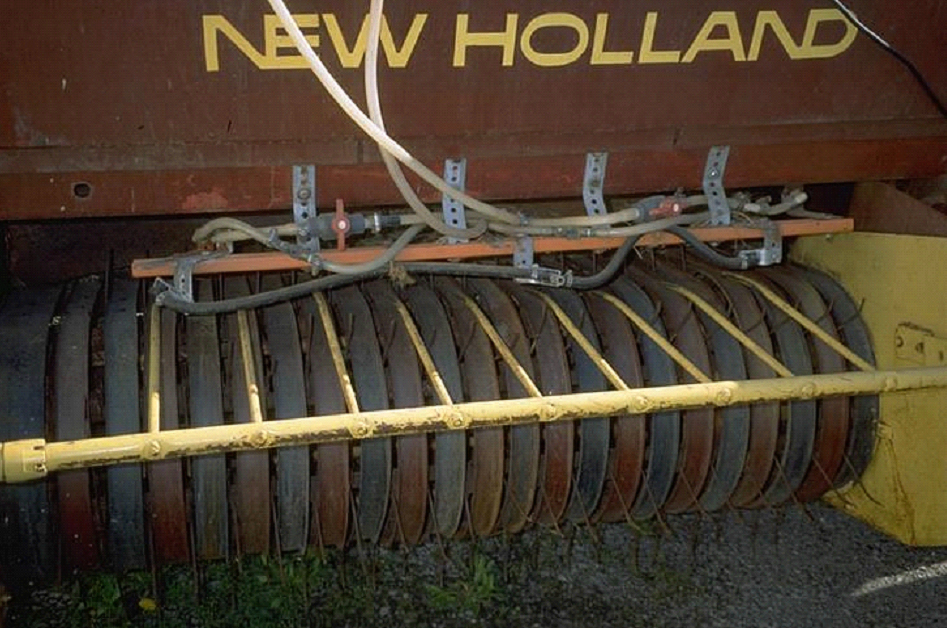 Hay preservatives can cause excessive corrosion on equipment.
Hay preservatives can cause excessive corrosion on equipment.Storage:
Alfalfa hay should always be stored under a shelter. Alfalfa bales will not shed water as well as bales of grass hay, and excessive storage losses occur when bales are stored outside. Also, bales should be stacked in a way that allows for some air movement through the stack.
Alfalfa as a Silage Crop
Ensiling alfalfa has certain advantages for producers who can use silage in their feeding programs. Unfavorable weather conditions that can cause significant losses in hay production are less of a problem. Fewer field losses (from leaf losses and respiration of plant tissue during drying) occur and a higher percentage of the nutrients in the forage can be preserved. Silage can be preserved for a long time and feeding can be mechanized to reduce labor requirements.
Crops such as corn have a naturally high level of soluble carbohydrates and ferment rapidly. This produces a great deal of lactic acid which lowers the pH and stabilizes the silage. Alfalfa, like other legumes, does not contain a high level of carbohydrates for natural fermentation, which limits the amount of lactic acid produced. Compounds within the alfalfa also act as a buffer, making the attainment of a low and stable pH even more difficult.
Under unfavorable conditions, poor fermentation resulting in low palatability, unpleasant odors and excessive storage losses can occur. However, alfalfa can achieve a good natural fermentation when properly managed.
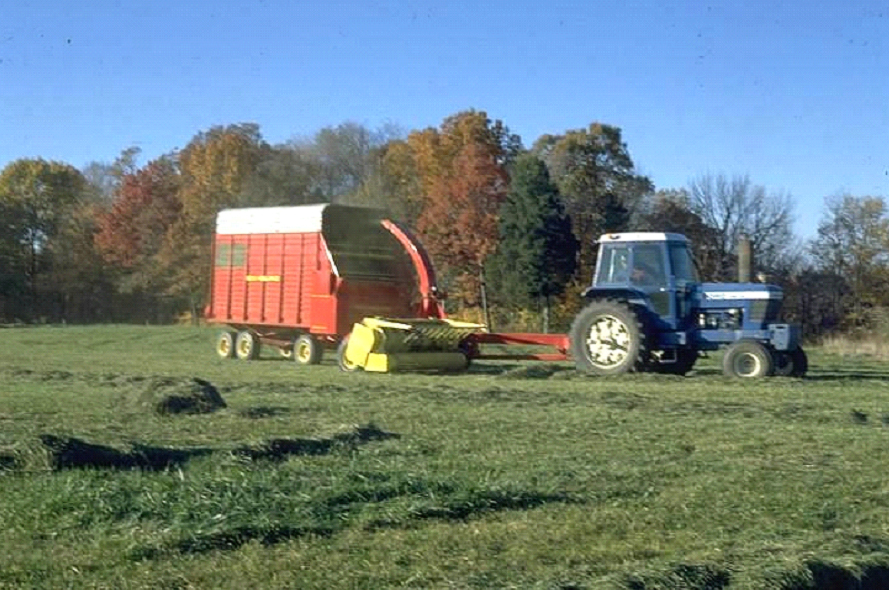 Wilted alfalfa being chopped for silage.
Wilted alfalfa being chopped for silage.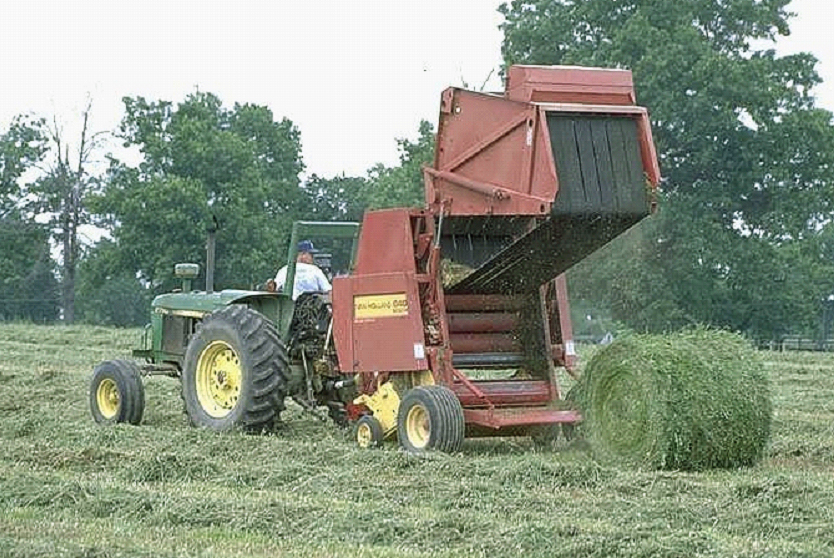 Alfalfa being baled for silage.
Alfalfa being baled for silage.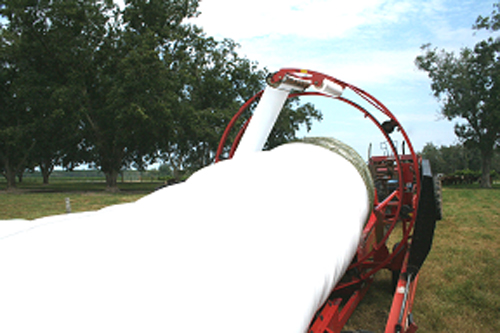 In-line hay wrapper.
In-line hay wrapper.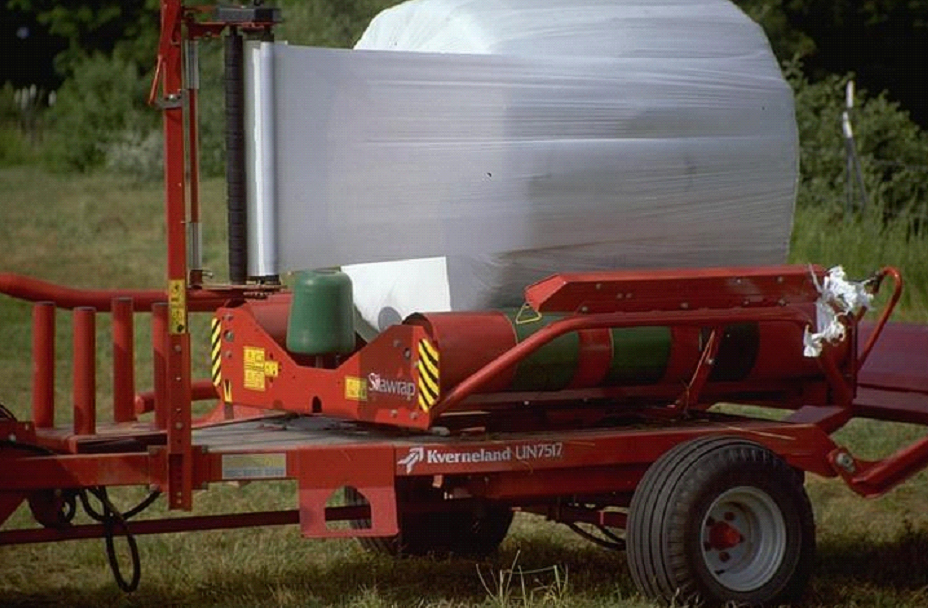 Individual bale wrapper.
Individual bale wrapper.Types of Silage: Alfalfa silage is generally created in one of three ways: direct cut, wilted and chopped, or wilted and baled. Standing alfalfa can be directly chopped and ensiled in conventional silos, but the high moisture content (80 percent or greater) will result in excessive effluent, and unpalatable silage may result from unfavorable fermentation. Adding a carbohydrate source such as crushed corn or molasses to the silage during the filling operation will usually improve fermentation and reduce seepage losses.
Cutting alfalfa and letting the crop wilt in the field to 65 to 70 percent moisture before chopping and ensiling will improve preservation. Only one to four hours of wilting will be required under average drying conditions. Wilted silage packs well and produces little or no effluent. Silage in this moisture range can be stored in horizontal silos, but losses of dry matter and nutrients will be greater than when silage is stored in upright silos.
Alternatively, alfalfa can be wilted and then baled using a large round baler. These bales can be wrapped with stretch-wrap plastic to exclude oxygen and then be ensiled. It is critical that the wrapper applies sufficient plastic to the bales. In-line wrappers that form a tube need to apply six to eight layers of stretch-wrap to each bale, with up to 10 layers applied at the locations where bales abut one another in the tube. Individual bale wrappers should apply a minimum of four layers, but six layers are recommended for bales that will be stored for more than 6 months. Silage bales should not be moved or handled until they are to be fed. Silage bales can be handled like large round hay bales, but silage bales are usually twice as heavy as the same size hay bales. Therefore, care should be taken to ensure that all equipment (balers, bale forks/spears, bale slicers, tub grinders, etc.) are capable of handling the heavier weight. Also, bale wrapping for hay must be done on-site where storage and feeding will occur. Dropping these wrapped bales off the wrapper and into a storage row with no additional handling is preferred. If wrapped bales must be moved to the storage site, any holes or damage to the plastic must be patched and sealed immediately.
Grazing Alfalfa
For many years, alfalfa was not considered capable of withstanding substantial grazing pressure. However, forage breeding efforts by Dr. Joe Bouton at the University of Georgia between the late 1980s and 2000s resulted in several grazing-tolerant varieties and “dual-use” (grazing or hay) alfalfa varieties that are now available. However, these varieties still must be correctly managed to maintain productive stands.
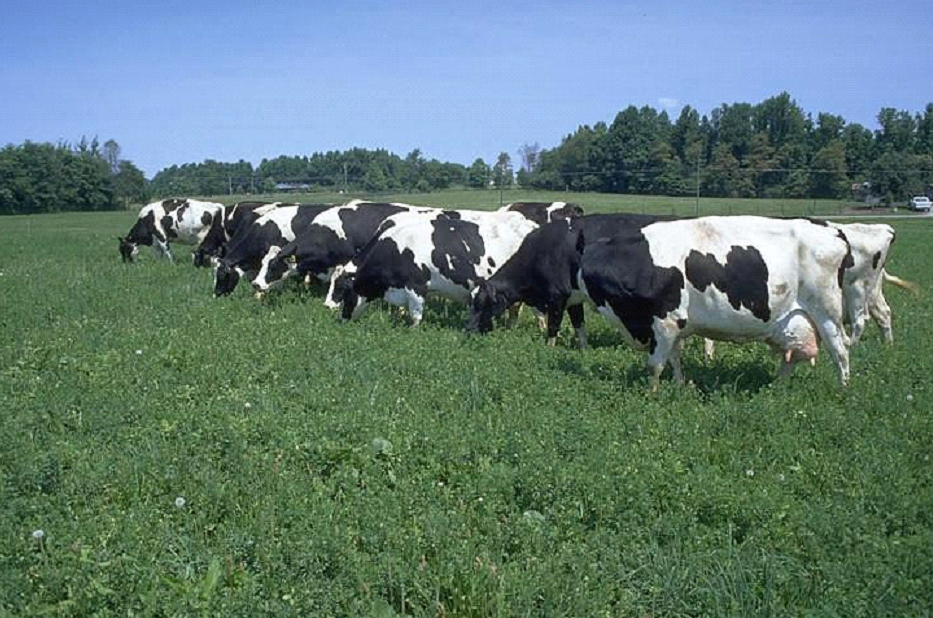 Grazing alfalfa provides high-quality pasture.
Grazing alfalfa provides high-quality pasture.When managing any alfalfa for grazing, some fundamentals must be kept in mind to ensure success. First, carefully select the grazing-tolerant variety. Any grazing-tolerant variety should have data showing its grazing performance. Ask for this information and use it to decide which variety to select. Secondly, obtain a strong alfalfa stand. Any grazing-tolerant variety will be subject to the same soil and management needs of hay-type alfalfas and must be treated as such. Use recommended establishment and management procedures for alfalfa in your area.
Thirdly, prevent bloat by never allowing hungry animals onto alfalfa. Ruminants can bloat on alfalfa. This usually occurs when an animal that has either been without feed or has an empty rumen is allowed to gorge on fresh alfalfa. It is best to feed a supplement containing monensin (Rumensin) and/or a chemical bloat preventative (Bloat Guard) to minimize the risk of bloat.
Finally, use some type of managed grazing (i.e., management-intensive grazing or rotational grazing). If a variety is truly grazing-tolerant, it should survive and perform well even under fairly substantial grazing pressures. However, the efficiency of alfalfa production is greatest when the stand is allowed to accumulate 10 to 16 in. of growth (usually early bloom stage), grazed to a stubble height of 2 to 4 in. in less than 4 days, and then allowed to rest for 15 to 30 days (or the time it takes to reach the grazing initiation height or early bloom stage). Longer grazing periods will cause stand loss, as grazers trample new growth buds.
The use of easy-to-move electric fences has made managed grazing easier for many producers. Managed grazing allows better control over the forage supply and reduces waste. In managed grazing, the efficiency of the system and the level of management increase when animals are rotated among more and smaller pastures (paddocks). However, if rotating animals among several small pastures is not feasible, using alfalfa for creep and limited grazing can allow the producer to give access only to those livestock that need it, with very little routine management effort.
For more information about managed grazing systems, visit our “Management-intensive Grazing” Web site at www.caes.uga.edu/Topics/sustainag/grazing/index.html.
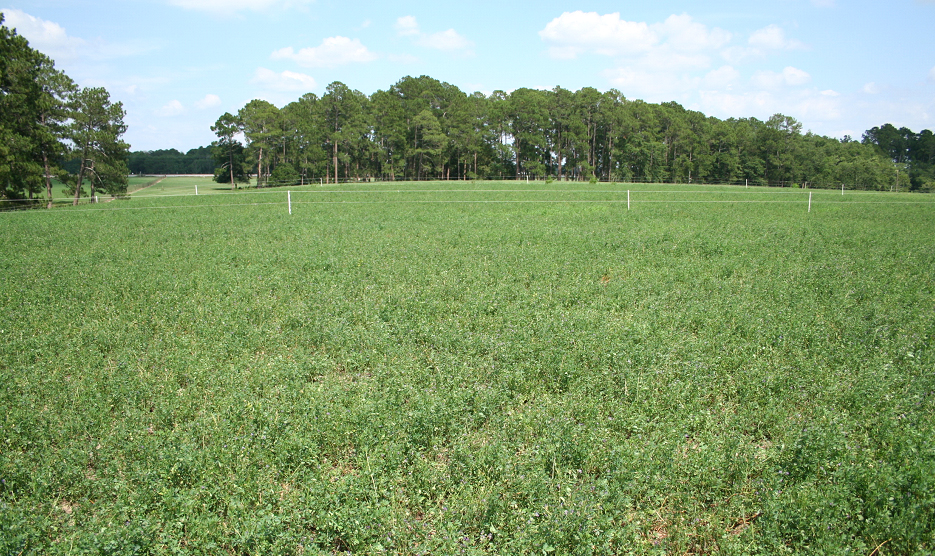 Alfalfa pastures in Tift County, Ga.
Alfalfa pastures in Tift County, Ga.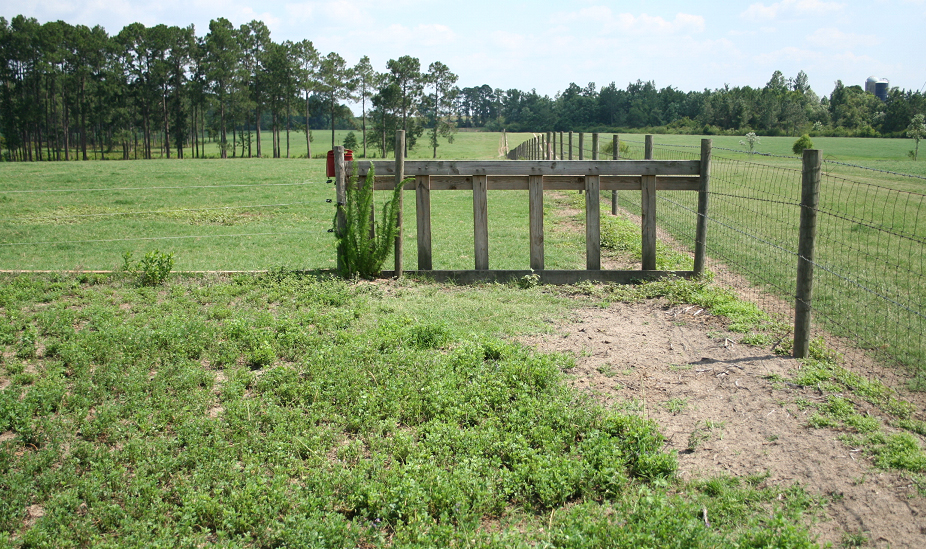 A creep-grazing gate allows calves to access an alfalfa field in Tift County, Ga.
A creep-grazing gate allows calves to access an alfalfa field in Tift County, Ga.Weed Control
Alfalfa is a vigorous, long-lived perennial forage that provides good ground cover from early spring until late fall. The plant recovers rapidly after harvesting and is a good competitor with most weeds.
Weeds are likely to be a problem during the establishment year and in subsequent years as stands thin or growth is slowed due to unfavorable moisture, low fertility, or poor harvest management. A good weed control program will increase stand productivity and, in many cases, extend the useful life of the stand.
Pre-Emergence
Fall-planted alfalfa is susceptible to competition from winter annual grasses (e.g., little barley, rescuegrass, annual ryegrass, etc.) and winter annual broadleaf weeds (e.g., chickweed, henbit, various mustard species, Carolina geranium, etc.). Though these weeds may seriously interfere with stand establishment in fall-planted alfalfa, summer annual and perennial weeds are much more aggressive in Georgia and make it difficult for spring-planted alfalfa to compete. This is one of the major reasons spring plantings of alfalfa are NOT recommended in Georgia, while northern and mid-western states recommend spring plantings.
Pre-plant herbicides that are incorporated into the soil immediately before planting are recommended in the Georgia Pest Management Handbook. These herbicides can provide excellent control of both grass and broadleaf weeds. The response of specific weeds to specific herbicides can be found in weed response tables in the Georgia Pest Management Handbook.
Some herbicides may cause temporary injury to seedling alfalfa but plants usually recover quickly with no lasting effects. Injury, which is expressed as stunted plants with leaves that do not unfold (margin leaf-sealing), is most likely to occur on sandy or coarse-textured soils.
Post-Emergence
 Post-emergence herbicide application on alfalfa.
Post-emergence herbicide application on alfalfa.Weed populations may interfere with the growth and development of alfalfa seedlings, particularly if pre-emergence treatments were omitted or if environmental conditions reduced the effectiveness of pre-emergence treatments. A limited choice of herbicides may be safely used on alfalfa seedlings after the three-leaf stage during the winter or early spring of the year of establishment. Apply treatments to small weeds as soon as alfalfa reaches minimum size, provided temperatures are warm enough to permit good activity (50° to 55° F minimum). Consult the current Georgia Pest Management Handbook for specific treatments and suggestions for proper use.
Weeds may encroach on alfalfa stands after hay harvesting begins, especially after the stand is 3 to 4 years old. Winter weeds may be especially trouble-some, as alfalfa growth is less vigorous during the winter and less competitive in preventing weed establishment. A good selection of contact and translocated herbicides is available for post-emergence application to dormant or semi-dormant alfalfa. Applications are usually made in January or early February to control winter annual grasses and broadleaf weeds, in order to eliminate weed contamination in the first hay harvest each year.
During summer periods after hay harvest, alfalfa is especially vulnerable to germination and establishment of annual grasses and broadleaf weeds. Summer annual grasses or broadleaf weeds are usually best controlled by applications between the time the forage is harvested and the alfalfa begins to regrow. Selected herbicides, outlined in the Georgia Pest Management Handbook, are available that can kill the weeds with minimal impact on alfalfa regrowth rate or yields.
Common bermudagrass is a particularly troublesome weed in established alfalfa. Currently-labeled chemicals may suppress this weed, but at labeled application rates will not kill common bermudagrass, even with sequential applications up to the allowable maximum application rate. Therefore, this weed should be well-controlled before planting alfalfa, and must be followed by application of a reliable pre-emergent herbicide.
Diseases
A number of diseases that affect alfalfa can kill seedlings, limit yields, reduce the quality of the forage, and shorten stand life. This section offers a brief overview of eight diseases (or disease complexes) that have been summarized from a number of other publications that describe these and other diseases in greater detail and aid diagnosis. These publications include the Alfalfa Analyst (published by the National Alfalfa and Forage Alliance and available at www.alfalfa.org/pdf/AlfalfaAnalyst.pdf); the Kentucky Integrated Pest Management: Alfalfa Diseases Page (https://ipm.ca.uky.edu/alfalfalist) and the more detailed Compendium of Alfalfa Diseases (published by APS Press).
Affected Areas: Stems (initially), crowns (eventually).
| Anthracnose | |
| Symptoms | Large, sunken, oval- to diamond-shaped lesions on stems. Lesions enlarge, join other lesions, and can girdle the stem(s). |
| Scouting Recommendations | Examine fields every 4 weeks in mid-summer and fall (July 15 to Oct. 1). Examine plants within a 20-ft radius. |
| Disease Severity Scale | 0 = no symptoms on stems or crowns of any plants. 1 = a few lesions found on some stems of a few plants, but no crown infections, little or no death of plants. 2 = lesions found on a number of plants, some dead, straw-colored stems scattered throughout the area. 3 = lesions observed on most stems of most plants, numerous dead stems found, thinning of stand apparent with anthracnose symptoms associated with crowns of dead or dying plants. (If entire crowns are dead, indicate as such.) |
| Comments | Infected crowns turn blue-black, produce fewer stems per plant, and the plant eventually dies. Moderate or higher resistance is available in many varieties. |
Affected Areas: Seedlings
| Aphanomyces Root Rot | |
| Symptoms | Seedlings (usually in wet soils) develop yellow cotyledons, chlorosis of other leaflets. Underside of leaflets may be reddened. |
| Scouting Recommendations | Examine plants in the field about 6 to 8 weeks after seeding. Examine five sites at least 10 to 20 ft from the field edge, especially in wetter areas of the field. |
| Disease Severity Scale | 0 = no plants diseased. 1 = less than 25% of plants in the site have modest stunting and yellowing. 2 = more than 25% of plants are showing symptoms; some scattered plants may show severe stunting. 3 = more than half of the plants at the site are extremely stunted (less than 2 in. tall) 6 weeks after seeding. |
| Comments | Avoid poorly-drained sites. Select resistant varieties. There are two races. Most resistance is to Race 1. Occasionally, resistance to Race 2 is needed. |
| Crown and Root Rot Complex | |
| Affected Areas | Crowns and taproots |
| Symptoms | Infected plants have leaves that wilt, turn yellow, then become bleached, often with a reddish tint. Crowns and roots contain reddish or brown rotting tissue. |
| Scouting Recommendations | Examine plants every 4 weeks from April to October. Examine any suspicious-looking plants within 100 ft of the monitoring site. |
| Disease Severity Scale | 0 = no infected plants; good, healthy stand. 1 = one plant has symptoms, appearance of some missing plants in stand. 2 = between 2 and 10% of plants infected; several areas where stand slightly thinned. 3 = more than 10% of plants infected, severe thinning of stands. |
| Comments | Minimize crown injury by avoiding traffic or grazing when soil is wet. Maintain good soil fertility (esp. K). Allow adequate regrowth between cuttings (4 to 6 weeks). Control leaf-feeding insects. |
Affected Areas: Leaves and stems
| Leaf Spot Complex | |
| Symptoms | Leaf spots that are tan, brown, or black; circular to oblong; may be raised above the leaf surface. Several types of leaf spots are common in alfalfa (e.g., common leaf spot, lepto leaf spot, etc.). Leaves with several or many spots may turn yellow and fall to the ground. |
| Scouting Recommendations | Examine plants in the field every week after the plant reaches late vegetative stages between mid-March and Sept. |
| Disease Severity Scale | 0 = no affected plants. 1 = a few lower leaves contain spots, but little or no defoliation. 2 = many leaves contain spots, some premature defoliation. 3 = leaves and stems peppered with spots, many leaves fallen on ground, all plants affected. |
| Comments | Fields receiving an average rating of 2 or more should be harvested early (but not before bud stage). Currently available varieties have little resistance. |
| Sclerotinia Crown and Stem Rot | |
| Affected Areas | Leaves and stems (initially), crowns (eventually). |
| Symptoms | Brown spots on leaves and stems, affected stems wilt and die, and the fungus infects the crown. When moist, a cottony fungus grows over diseased areas. Black bodies called sclerotia, about the size of BBs, form in this fungus growth or on dead stems. |
| Scouting Recommendations | Examine plants in the field every 2 to 4 weeks from mid-Feb. - April. |
| Disease Severity Scale | 0 = no affected plants. 1 = only 1 to 2% of plants show typical symptoms. 2 = 2 to 15% of plants affected. 3 = more than 15% of plants affected. |
| Comments | Damage is least severe in fields established using conventional tillage. Use Sclerotia-free seeds when planting. More likely in the Georgia Mountains or in very mild winters and springs. |
| Spring Black Stem and Leaf Spot | |
| Affected Areas | Leaves and stems |
| Symptoms | Small, irregularly-shaped, black to dark brown spots develop on the lower leaves and stems. Diseased leaves turn yellow, wither, then fall. Lesions on the stems may girdle and blacken large areas near the base of the plant. |
| Scouting Recommendations | Examine plants in the field every week after the plant reaches late vegetative stages from mid-Feb. to April. |
| Disease Severity Scale | 0 = no affected plants. 1 = a few lower leaves contain spots, but little or no defoliation. 2 = many leaves contain spots, some premature defoliation. 3 = leaves and stems peppered with spots, many leaves fallen on ground, all plants affected. |
| Comments | Fields receiving average rating of 2 or more should be harvested early (but not before bud stage). Early harvest will reduce leaf loss. Spring black stem is favored by cool, moist weather and the first cutting in the spring is usually the most damaged. Varietal resistance is highly variable. |
| Summer Black Stem and Leaf Spot | |
| Affected Areas | Leaves and stems |
| Symptoms | Leaf spots are somewhat larger than those of spring black stem, usually 1/8- to 1/4-in. in diameter. Spots are reddish brown to light gray and often surrounded by a yellow halo. Stem lesions are dark brown. |
| Scouting Recommendations | Examine plants in the field every week after the plant reaches late vegetative stages from mid-May to Sept. |
| Disease Severity Scale | 0 = no affected plants. 1 = a few lower leaves contain spots, but little or no defoliation. 2 = many leaves contain spots, some premature defoliation. 3 = leaves and stems peppered with spots, many leaves fallen on ground, all plants affected. |
| Comments | Fields receiving average rating of 2 or more should be harvested early (but not before bud stage). Early harvest will reduce leaf loss. Summer black stem is favored by hot, humid weather. Currently, available varieties have little resistance. |
| Southern Blight or Stem Rot | |
| Affected Areas | Leaves and stems (initially), crowns (eventually). |
| Symptoms | One or more individual branches turn yellow, wilt, and die. Disease lesions are light tan to brown and often develop into a dry rot. In humid conditions, the fungus produces a white moldy growth over infected stems similar to Sclerotinia. Produces tan to brown, mustard seed-sized sclerotia. |
| Scouting Recommendations | Examine plants in the field every 2 to 4 weeks from mid-May to Sept. |
| Disease Severity Scale | 0 = no affected plants. 1= only 1 to 2% of plants show typical symptoms. 2 = 2 to 15% of plants affected. 3 = more than 15% of plants affected. |
| Comments | Southern stem rot is a hot weather disease. |
Disease Management
The occurrence and severity of these diseases depend on soil conditions, crop management, and environmental stresses. Since no chemical control options are available, the only way to control these diseases is to practice good management. Cultural practices that maintain healthy growth can be achieved by abiding by the following recommendations:
- Select varieties that have a "Resistant" (R) rating (or higher) to as many diseases as possible.
- Select a well-drained, deep, and fertile site for alfalfa production.
- Use high-quality and, when possible, fungicide-treated seed.
- Maintain an appropriate soil pH and adequate levels of soil nutrients.
- Control insects and weeds to prevent wounds, stress, competition, or reductions in air circulation.
- Minimize crown injury by avoiding the use of heavy equipment or grazing when the soil is wet.
- Cut alfalfa at the early-bloom stage to prevent the buildup of foliar diseases.
- Harvest young stands before older ones to prevent the spread of disease from old to new stands.
- Cut only when foliage is dry.
- Cure, bale, and remove hay promptly.
- Practice good fall harvest management and remove freeze-damaged stems in a “freeze-down” harvest after a killing frost.
- Rotate crops and ensure that alfalfa does not follow other legume crops.
Nematodes
Several species of parasitic nematodes infect alfalfa. Nematodes can affect stand establishment, promote increased susceptibility to root and crown diseases, reduce stand life, and cause yield losses.
Alfalfa is generally classified as being affected by root-knot, lesion, stubby root and lance nematodes. Although not confirmed by research, nematologists suspect that the sting nematode will also injure alfalfa. Nematodes are more likely to affect alfalfa on the sandy soils of the Coastal Plain and on sandy river bottoms in north Georgia.
Nematode damage appears as stunted, yellow to light green areas in a field. Root damage symptoms include stunted root systems, stubby feeder roots, and knots on the roots similar to nodules. No nematicides are registered for use on alfalfa. Avoid planting in fields where damaging populations of nematodes occur. Nematologists can determine nematode population levels by extracting and counting juvenile nematodes found in soil samples taken for that purpose. Contact your county Extension agent for more information on sampling for nematodes.
Insects
Alfalfa grown in Georgia is subject to attack by a wide variety of insect pests. However, only a few of these pests occur at population levels capable of causing economic damage to the crop in most years. Knowledge of the seasonal occurrence of insect pests, their appearance and damage symptoms, and means by which they can be controlled will help growers minimize economic losses to their alfalfa crops.
Foliage Feeding Insects
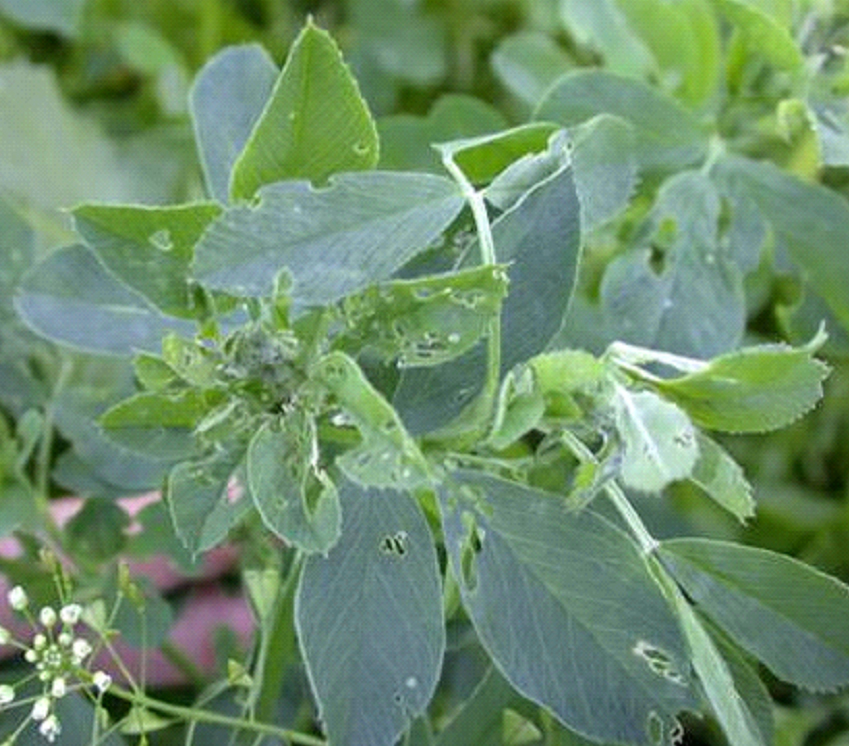 Alfalfa weevil tip feeding damage.
Alfalfa weevil tip feeding damage.Alfalfa Weevil:
The alfalfa weevil is considered the most serious alfalfa pest in Georgia. Both larval (worm or grub) and adult stages attack the plants. Larvae are most damaging to the first crop of the season and adults can be present in damaging numbers during regrowth of the second crop. Their feeding causes loss of both yield and quality.
Alfalfa weevils overwinter as both adults and eggs. Eggs are deposited within alfalfa stems in the fall through early spring. Eggs hatch, depending on temperatures, in late February to early March and the larvae move to the tips of the plants. If left uncontrolled, larvae will feed for 2 to 3 weeks. The small larvae feed within the plant terminals, causing a “ragging” of leaves emerging from the terminal buds. Larger larvae usually feed more on the leaves that have already emerged. When present in large numbers, larvae cause severe defoliation and fields appear frosted or grayish. In very mild winters, weevil larvae can begin feeding in early winter and control measures may be needed.
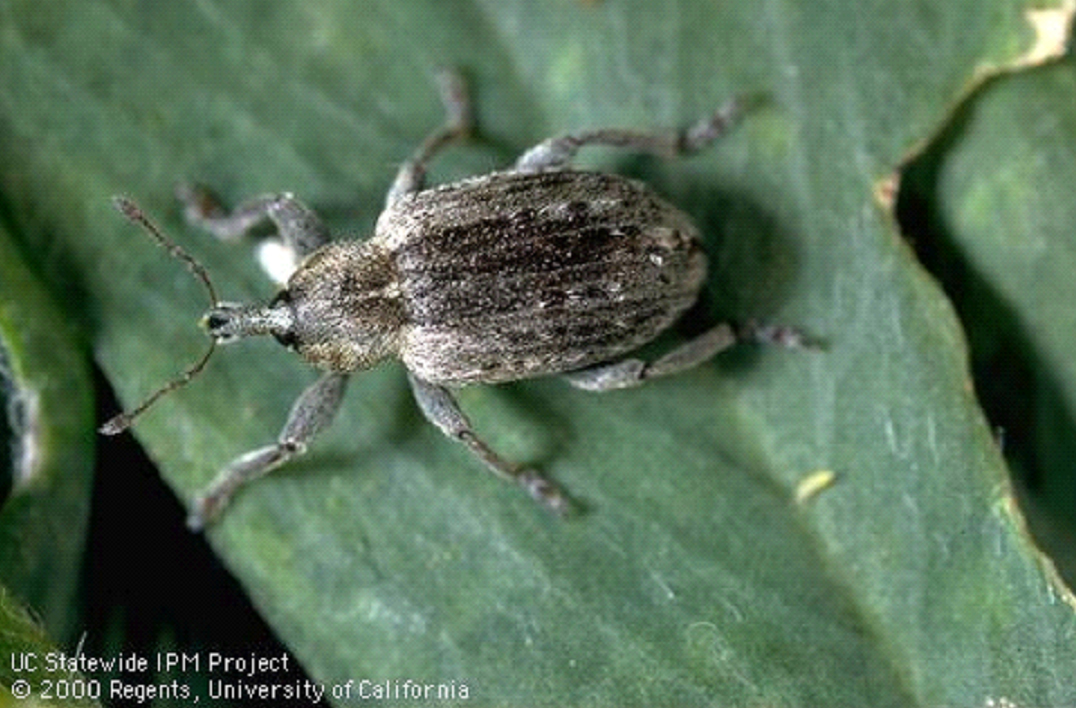 Alfalfa weevil
Alfalfa weevil(Photo by Jack Kelly Clark, courtesy of UC Statewide IPM Program).
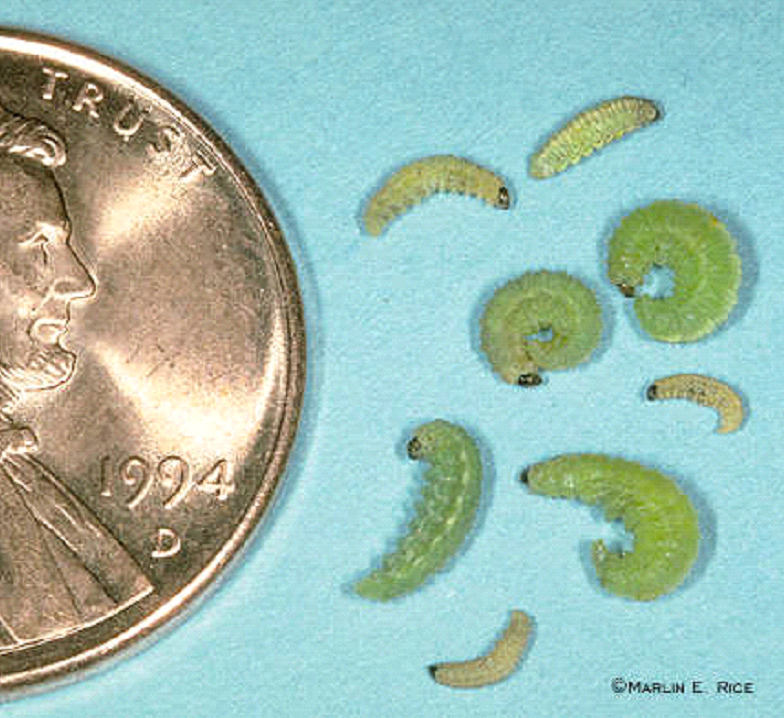 Alfalfa weevil larvae
Alfalfa weevil larvae(Photo courtesy of Marlin Rice, Iowa State University).
As the first harvest approaches, most weevil larvae spin cocoons in debris on the soil surface and enter the pupal stage. An adult will emerge from each of these cocoons after 2 to 3 weeks of pupation and begin feeding on alfalfa. They normally feed for a short time to build up food reserves and then move into vegetation along field margins, where they remain inactive during the summer months. With the return of cool weather conditions in the fall, the adults return to the alfalfa fields.
In Georgia, at least one insecticide application will be needed in most fields every year to control alfalfa weevils in established alfalfa. In most years, alfalfa larvae can be present in damaging numbers early in the first growth cycle (late February through mid-March) when stems may still be short. In cool springs, larvae may occur later in the first growth cycle. Sample larvae with either a sweep net or a shake-bucket technique. Insecticide control is justified if larval numbers exceed 20 larvae per sweep and 30 percent of terminals show damage. For the bucket technique, carefully pick 30 stems randomly per field, place them in a white plastic bucket, and beat stems against the side of the bucket. Count the larvae and divide by the number of stems. Shake-bucket thresholds are based on stem heights (Table 4). If stems are very short and most larvae are very small (1/16-in. long), most likely the eggs are still hatching and treatment should be delayed to allow most eggs to hatch before treatment.
| Table 4. Treatment thresholds for control of insect pests of alfalfa. | |
| Pest | Threshold level(s) |
|
Alfalfa weevil larvae |
20 or more larvae per sweep 5–8 in.: 0.5 larva per stem 9–14 in.: 1.0 larva per stem 15 in. or more: 1.5 larvae per stem |
| Clover leaf weevil and lesser clover leaf weevil larvae | 30% infested stems |
| Aphids (based on stem height) |
Less then 15 in.: 40 aphid per stem 15 in. or more: 80-100 aphids per stem |
| Potato leafhopper (based on stem height) |
3–7 in.: 0.5 hopper per sweep 8–10 in.: 1.0 hopper per sweep 11–14 in.: 2.0 hoppers per sweep 14+ in.: 4.0 hoppers per sweep or cut early |
| Leaf-feeding caterpillars, cutworms | 10% defoliation |
| Grasshoppers | 10% defoliation or 10 nymphs per square yard |
| Soil insects or Green June beetle larvae | 2 per square yard |
| Three-cornered alfalfa hopper | 10% infestation of seedling stands or Girdling of 10% of stems in established stands |
In Georgia, alfalfa weevils almost always need control several weeks before normal harvest. Sometimes, in cool springs or in the northern part of the state, damaging populations may occur near harvest them bud stage to first bloom stage. At this point, consider harvesting early with a mower-conditioner, which will kill most larvae. Grazing cattle also can be used as a weevil larvae control measure for the first harvest. Check stubble 4 to 6 days after mowing or grazing for possible damage by surviving larvae or new adults. Stubble sprays may be required, especially in fields not sprayed before harvest, to prevent damage during regrowth of the second crop.
When selecting an insecticide for alfalfa weevil, carefully consider the product harvest interval. Some older products at higher rates can have a very long harvest interval.
Aphids: Aphids also can be a serious alfalfa pest in Georgia. They are often especially damaging during years with cool, wet conditions that allow for maximum aphid population development. Aphids insert their mouthparts into plants and feed directly on plant juices. Their feeding usually does not cause obvious yellowing or stunting, but large numbers can reduce plant vigor and growth.
Two aphid species typically attack alfalfa in Georgia: the pea aphid and the spotted alfalfa aphid. A third species, the blue alfalfa aphid, has been found in Georgia but rarely is a problem in the state. The pea aphid is light green and larger than the spotted alfalfa aphid. It usually occurs on the first crop of the season. Damage symptoms include yellowing of infested foliage and possible wilting of plants due to removal of plant fluids. The spotted alfalfa aphid is pale yellow to white with several rows of dark spots along its back. Damage symptoms appear as a yellowing of the foliage between the leaf veins.
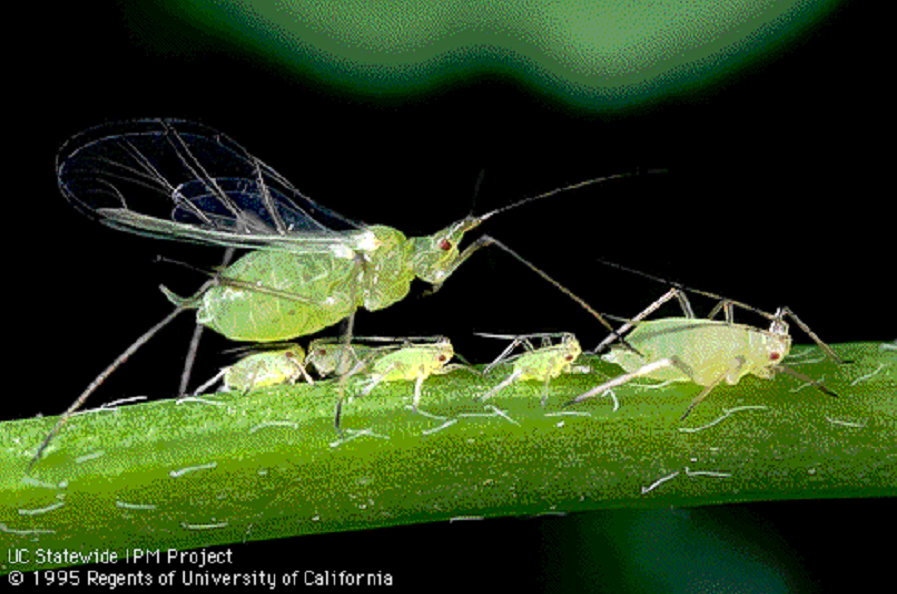 Pea aphids
Pea aphids(Photo by Jack Kelly Clark, courtesy UC Statewide IPM Program).
 Spotted alfalfa aphids
Spotted alfalfa aphids(Photo by Jack Kelly Clark, courtesy UC Statewide IPM Program).
Initiate control against aphids when heavy infestations begin to cause yellow and/or loss of vigor. Treatment thresholds are not well established but consider insecticidal control if numbers exceed 40 aphids per stem when alfalfa is less than 15 in. tall or 80 to 100 aphids per stem if alfalfa is 15 in. taller. If alfalfa is close to harvest maturity, harvest early and treat stubble as needed. Natural enemies such as lady beetle larvae and adults and various parasites usually keep the aphid population in check. Lady beetles are not active during the winter, so large aphid populations may build up in late winter on non-dormant alfalfa before lady beetles become active. If spotted alfalfa aphids appear in seedling stands, treat when they can be easily found in the field. This aphid is capable of severely stunting or destroying alfalfa seedlings.
Potato Leafhopper:
Potato leafhoppers sometimes reach damaging levels in later alfalfa growth cycles between July and September in Georgia. They feed on leaves and stems by sucking plant fluids. Their feeding causes a toxic reaction that typically causes the tips of leaves to turn yellow. This injury forms an inverted V-shape from the tip and is called “hopperburn.” Severe damage will stunt plants and make the stand appear yellowed.
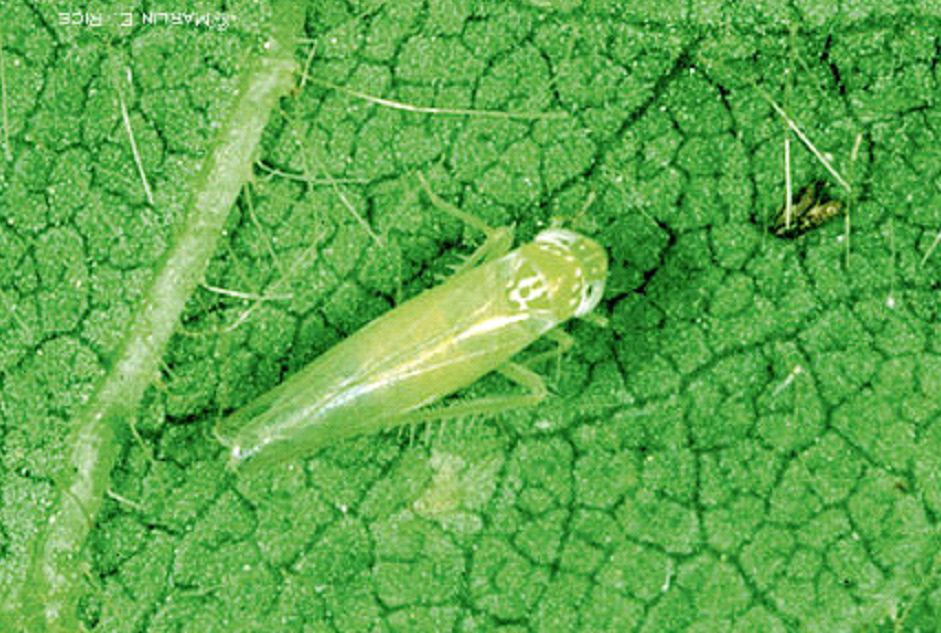 Potato leafhopper adult
Potato leafhopper adult(Photo courtesy of Marlin Rice, Iowa State University).
 Potato leafhopper nymph and “hopperburn” caused by feeding injury
Potato leafhopper nymph and “hopperburn” caused by feeding injury(Photo courtesy of Oklahoma State University).
Potato leafhopper nymphs are very small, 1/16- to 1/32-in. long, and adults are 1/4-in. long. Both are greenish yellow and elongated. Sampling is based on sweep net samples. Take 10 sweeps per spot in five spots per field. Insecticide treatment thresholds are based on stem height and range from 0.5 to four hoppers per sweep, depending on stem height (Table 4). Several insecticides are available; pyrethroid insecticides usually provide good control.
Alfalfa varieties with resistance to potato leafhoppers have been developed and may be available. These varieties generally are more tolerant of leafhopper damage, with damage usually being reduced to a point where treatment is not needed. However, potato leafhopper resistance has not been extensively evaluated in Georgia.
Three-cornered Alfalfa Hopper:
Three-cornered alfalfa hoppers are so named because adults have a large triangular shield over their back. Nymphs are teardrop-shaped and have a line of small spines along the back. Both nymphs and adults are green and have piercing-sucking mouthparts. They feed on alfalfa stems, often girdling the stem less than 1 in. above the soil surface and causing the stem to wilt and die. In Georgia, this insect also causes similar damage to soybean and peanut. Three-cornered alfalfa hopper usually does not need to be controlled in alfalfa. Treatment threshold is 10 percent of stems being girdled and dying.
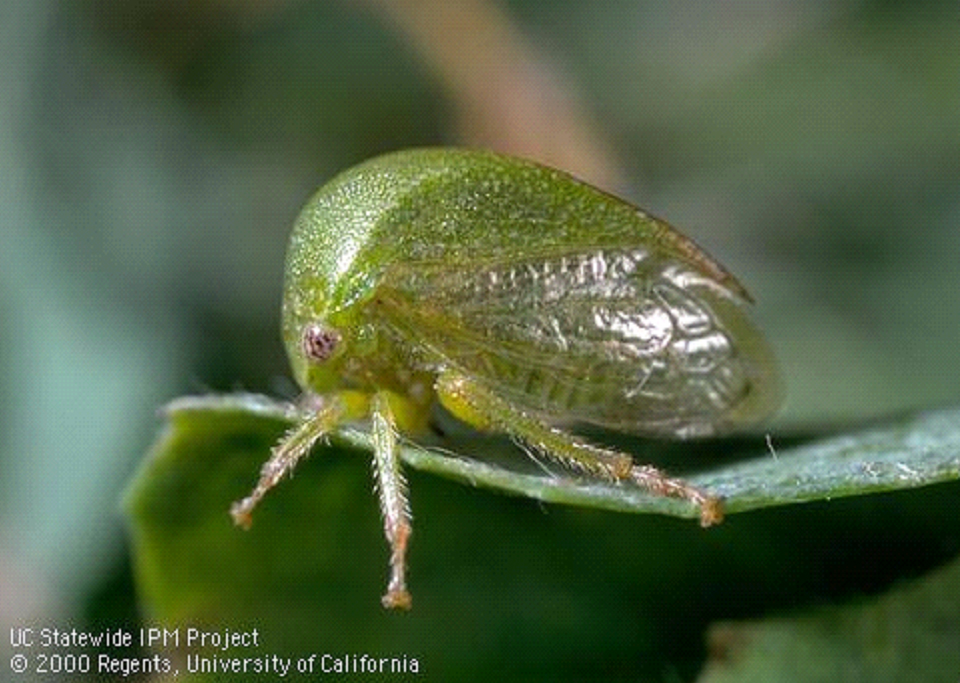 Three-cornered alfalfa hopper
Three-cornered alfalfa hopper(Photo by Jack Kelly Clark, courtesy UC Statewide IPM Program).
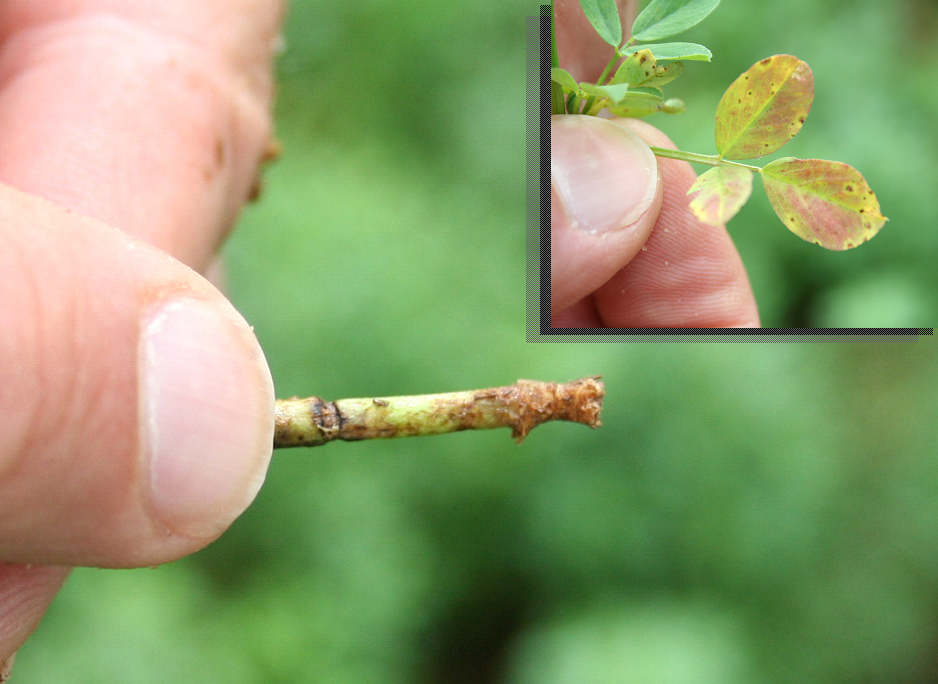 This stem was girdled by the three-cornered alfalfa hopper and the leaves show the effects.
This stem was girdled by the three-cornered alfalfa hopper and the leaves show the effects.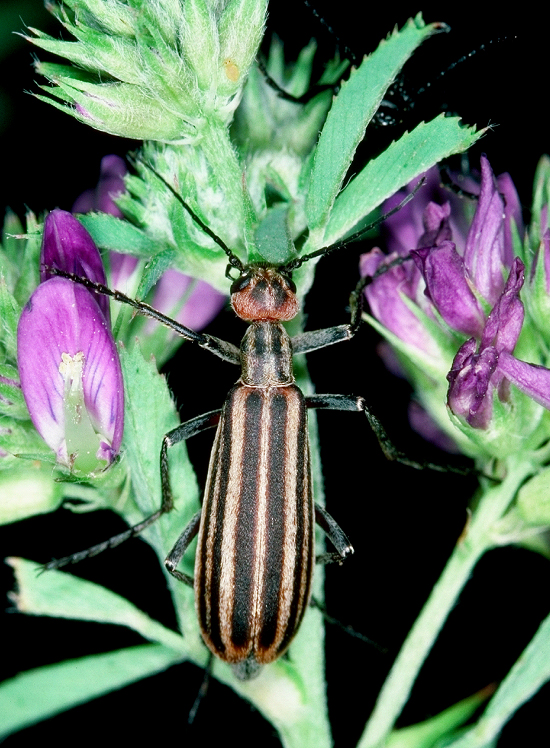 Striped blister beetle
Striped blister beetle(Photo courtesy of Marlin Rice, Iowa State University).
Blister Beetles:
Several species of blister beetles may infest alfalfa in Georgia. Blister beetles feed on foliage but rarely cause significant defoliation. Instead, their bodies contain a very toxic chemical that contaminates hay. This compound, cantharidin, can be toxic to livestock especially horses. The striped blister beetle is the species usually associated with alfalfa hay poisonings. Generally, the first cutting is at low risk of infestation; beetles usually occur after that time and peak in late summer. Blister beetles can aggregate in very large numbers, often along the field margin. For more detailed information on blister beetle management in alfalfa see UGA Extension Circular 917.
Others:
Later in the growing season, lepidopteran (caterpillar) larvae, including green cloverworm, velvetbean caterpillar, alfalfa butterfly larvae, and various armyworm species, may cause defoliation. These caterpillars can be considered as a group and control considered when defoliation exceeds 10 percent. Grasshoppers also may cause defoliation, especially in dry years. Several other weevil species (such as clover leaf weevil) may occasionally infest alfalfa and cause damage similar to the alfalfa weevil. Check Table 4 for treatment thresholds for these and other alfalfa pests.
Soil Insects
Various soil insects such as white grubs, wireworms, or whitefringed beetle larvae may cause stand losses when establishing new alfalfa plantings. Inspect fields before planting to determine whether soil insects are present. Since these insects bury themselves quickly in the soil (within seconds), inspection should be made immediately after turning the soil. If any of these pests are found at an average of two larvae per square yard, a pre-plant or at-planting insecticide may be beneficial. The only insecticide currently available for soil insect control during alfalfa planting is chlorpyrifos (Lorsban, Chlorfos and other brands). The liquid formulation (4E) can be applied pre-plant and incorporated, or the granular formulation (15G) can be applied in-furrow at planting. Control may be variable depending on soil conditions and infestation size.
If alfalfa is to be planted following grass sods, inspect the sod for infestations of mole crickets or green June beetle larvae. Infestations are indicated by fluffiness of the top 1 to 2 in. of the soil and the presence of holes (1/4- to 3/4-in. in diameter). No effective chemical controls are available for use against mole crickets in alfalfa, but green June beetle larvae can be controlled with recommended insecticides.
Management
A proper crop management program can ensure high alfalfa yields and quality. Follow recommended agronomic practices (fertilization liming, weed control, seeding, etc.) to achieve and maintain vigorous crop stands. Healthy plants tend to tolerate and/or outgrow insect damage more efficiently than plants not receiving proper care. Check fields for insect problems at least weekly during the growing season. Maintaining a field report at each sampling may help determine whether a population is increasing or decreasing.
Inspect each field; insect populations differ among various locations. Examine plants at three to four locations for every five to 10 acres in a field. A sweep net may be used in these examinations, but use the “bucket method” when scouting for alfalfa weevil. In the “bucket method,” entire stems from the sample locations (a total of 30 stems from representative areas of the field) are collected and shaken inside a bucket to dislodge the weevils from the stems, and the alfalfa weevils are counted. If a damaging population is present, early cutting can be a very effective means of control. Check stubble for surviving pests within 4 to 6 days after cutting and treat the stubble if regrowth is delayed. Specific treatment threshold levels and insecticide recommendations for all alfalfa pests are updated annually in the Georgia Pest Management Handbook and may be obtained from your county Extension office.
Use insecticides judiciously in alfalfa. Numerous beneficial insect predators and parasites can be found in alfalfa fields during the entire growing season. These beneficials help suppress many different insect pests. Also avoid applying insecticide to flowering alfalfa to prevent killing bees. In addition, be aware of the restrictions for individual insecticides with regard to the interval between spray and harvest when you select the best insecticides for your situation.
Alfalfa Utilization
Alfalfa is one of the highest-quality forages available to livestock producers in Georgia. It is high in crude protein and above average in energy. As a result, it is sometimes used as the primary forage for grass-fed livestock systems where pastured animals require high levels of nutrition from their pasture rather than from grain-based supplements.
For conventional livestock systems, however, alfalfa normally supplies more protein and energy than is required for most classes of animals. For this, as well as economic reasons, good quality alfalfa is typically used as a supplement in feeding programs in Georgia rather than as the primary forage in livestock rations. This supplement can be provided by allowing animals to limit-graze alfalfa or alfalfa/grass pastures, but most commonly is provided by using alfalfa hay as an ingredient in a balanced ration.
The following examples provide the considerations necessary for feeding alfalfa hay as a high-quality forage supplement. In the interest of brevity, these sections only consider the use of alfalfa hay in rations for the three major forage-based livestock systems in Georgia: beef cow-calf, dairy cows, and horses.
Certainly, there are many other livestock enterprises where alfalfa can be utilized. The following suggested rations are meant only as guidelines. There will be substantial differences in each scenario, even within the examples detailed here. Thus, it is best to consult with your county Extension agent or animal nutritionist about how to use alfalfa in your specific livestock feeding program(s).
Using Alfalfa Hay in Livestock Feeding Systems
When alfalfa is harvested for hay following best management practices (see previous sections), the forage will generally contain 61 to 64 percent TDN and 18 to 22 percent protein (Table 5). By virtue of being comparatively higher in quality than grass hay, alfalfa is most often used as a substitute for grass hay in the ration.
| Table 5. Comparison of the typical forage quality of grass and alfalfa hay when harvested at the recommended stage of maturity. | ||
| Nutrient | Grass Hay | Alfalfa Hay |
| CP | 9 – 11% | 15 – 18% |
| TDN | 55 – 58% | 61 – 64% |
| RFQ | 90 – 115 | 125 – 180 |
Although it can be exceptionally high, alfalfa quality varies considerably (as do most other feedstuffs). Unfortunately, quality cannot be adequately assessed without a forage analysis (see the “Your Senses Can Be Deceiving” inset). It is critical that an analysis be used to determine the true nutritive value before the forage can be most effectively used in the ration.
Additionally, animals that have been switched to a diet that contains relatively high amounts of alfalfa (more than 25 percent) may need time to adjust to the change in quality. In these transitions, alfalfa may have a mild laxative effect on some animals. In general, animals acclimate to alfalfa-rich diets within 2 weeks.
Your Senses Can Be Deceiving
Green color in a hay crop does not equal high quality. Alfalfa hay that is produced in western states is often a bright green color. This side effect of more arid curing conditions is not very indicative of energy content, fiber digestibility, or protein level. Thus, the use of color as an indicator of forage quality is overrated and can be quite deceiving. This essentially cosmetic trait is sought by hay buyers, but it is more important to the person than to the animal (cattle and horses are unable to distinguish green from brown).
However, the smell of hay can be used to identify problems not seen in analyses of forage quality. As with all hay crops, alfalfa hay can contain excessive mold or dust when baling conditions were less than ideal. Good alfalfa hay should have a fresh, pleasant smell rather than a moldy or dusty odor. Moldy or dusty smelling hay is a reasonable (but still rather subjective) indicator of mold or dust. However, mild odors or the lack of hay odor should not be thought of as conclusive indicators of mold or dust content. For example, if the hay was recently baled (less than 3 weeks), its mold content (and smell) may change in time.
Beef
Alfalfa can serve as a good supplement resource for beef cattle producers in Georgia because it provides an excellent source of protein and energy. Alfalfa hay that does not meet dairy/horse specifications may be purchased cheaper than many typical supplements. However, as with any supplementation strategy, feedstuffs should be evaluated on a per-nutrient basis to assure the most economical decision is made.
A typical supplement for a 1,000 lb. lactating cow is a 50:50 blend of corn gluten feed and soyhulls fed at 7 lb a day (77 percent TDN, 15 percent CP). In order to compare the value of alfalfa hay to this supplement we need to define the amount of alfalfa hay needed to equal the amount of supplement (Table 6). Currently, energy is the most expensive nutrient to feed cattle and should be the first nutrient balanced.
| Table 6. Comparison of a 50:50 blend of corn gluten feed and soyhulls to medium-quality alfalfa hay. | ||
| TDN | CP | |
| —— % —— | ||
| Corn Gluten Feed/Soyhull (50:50 blend) | 77 | 15 |
| Alfalfa Hay (medium-quality) | 62 | 15 |
Alfalfa hay (medium-quality) contains approximately 80 percent of the energy (TDN) of the corn gluten: soy hull supplement. Therefore, alfalfa’s value is 80 percent of the typical supplement (based on energy content).
Guidelines for Feeding: Feeding alfalfa as a supplement to other forages may present problems that should be considered. Care must be taken to ensure that the alfalfa supplement is equally available to all animals. The following guidelines will help in planning how to properly use alfalfa in your program.
Frequency of feeding:
It is best to feed on at least a daily basis. A suitable alternative would be to feed double the amount on alternate days. Feeding alfalfa less frequently (every third or fourth day) may cause digestive problems and reduce performance.
Form of feeding:
Alfalfa is best handled in square bales. Feeding as long-stemmed hay is preferred. Provide hay in troughs or racks, not on the ground. Hay fed on the ground will cause high losses due to leaf shatter and trampling. Round bales of alfalfa can be fed, but limiting access to the forage is more challenging. Grinding bales in a tub grinder is a suitable alternative if it is not ground too finely. A grind of 1/2 to 1 in. is best.
Trough space:
Since alfalfa hay should be hand-fed, adequate trough space is a must. Provide 1 1/2 to 2 linear feet per head so all cattle can eat at once.
These suggestions are meant as guidelines. There are many ways to feed alfalfa successfully. The key is to know the nutrients available in pastures and grass hay, and to allow all animals adequate alfalfa supplement on a regular basis without overfeeding.
Dairy Cow
The dairy cow is a ruminant that requires a large amount of forage (fiber) in her diet. Alfalfa is a high-quality, highly-digestible forage that is relatively high in calcium and energy content, relative to other forage crops. Alfalfa is known for its ability to meet most of the cow’s nutrient requirements and, as a result, has been used in dairy rations for several decades. It has proven to be a forage that aids milk production and is adapted to many feeding schemes.
For the dairy cow, fiber, protein, energy, and calcium are critical nutrients. Adherence to several ration balancing rules of thumb should ensure that there is adequate fiber in the dairy cow’s diet. These requirements include at least 40 percent of her dry matter intake (DMI) to be roughage, 17 percent crude fiber (CF), 33 percent neutral detergent fiber (NDF), 23 percent acid detergent fiber (ADF), and 75 percent of the NDF should be from forages. All of these percentages are required to get enough fiber in the ration to maintain rumen microbial activity and slowly release volatile fatty acids (VFA) from the fermentation of cellulose and hemicellulose. The major VFA produced in the rumen is acetate. Acetate is critical to the dairy cow because it is used by the mammary gland to produce milk fat. Fifty percent of the cow’s milk fat is synthesized in the mammary gland. If too much grain is fed, less acetate will be produced and milk fat depression will occur. If this continues, rumen pH will decrease and acidosis will occur. Adequate forage in the diet is the best prevention of acidosis.
The protein content for the lactating dairy cow should be 14 to 17 percent, depending upon her level of production. Having more protein available in the forage allows more flexibility in balancing rations and less need to purchase protein supplements. The protein content in alfalfa is relatively high for a forage crop, and it is readily available to the dairy cow.
Energy is often limiting in the ration of the early-lactation or high-producing dairy cow. The cow cannot eat enough feedstuffs to meet her milk production demands. Because of the need to maintain the fiber level for milk fat production, energy will be limited because of intake restrictions. The higher the energy in forage, the closer the ration can come to meeting the dairy cow’s energy need. Alfalfa is a high-energy forage that can be used to balance the cow’s need for fiber and energy.
Milk is an excellent source of calcium for humans. To provide this level of calcium, the dairy cow has a high calcium requirement. To produce 50 lbs. of 3.5 percent milk, the cow must have 0.13 lbs. of calcium in her diet above her needs. Alfalfa is high in calcium and can help to meet this requirement.
Feeding Systems:
Alfalfa is often fed as the sole forage in the West and Midwest. In the Southeast, alfalfa is typically fed in limited amounts as supplemental forage. This means it is most effectively used when it can be blended in a mix to ensure all cows have access to the alfalfa. The way alfalfa is fed to dairy cows will depend upon the form of preservation chosen for the forage. Alfalfa can be harvested and stored as silage, low-moisture silage (haylage), or hay. The form chosen will depend upon harvest time, equipment, storage facilities, feeding system, labor, and capital. Silage, haylage, or chopped hay can be used in total mix rations (TMR) for dairy cows. The interactions of these variables will determine which form a dairy producer will use.
For many producers, the flexibility to harvest their alfalfa in different forms is essential to managing the crop. Harvest time, drying time, and competition with the harvest of other crops will determine how the farmer will harvest and store the crop. As alfalfa production has increased in the Southeast, more alfalfa hay is grown as a cash crop to sell. Competition from the horse market will determine the availability of alfalfa for dairy cattle.
Table 7 lists feed ingredients for a basic corn silage ration using feed ingredient prices averaged from the 2000s and the prices for 2008. Recent prices have increased dramatically due to ethanol demand for corn, global demand for U.S. feed stocks, increased energy prices, increased fertilizer costs, and other economic challenges.
| Table 7. Prices for feed ingredients in a base ration with average 2000s prices and 2008 prices. | ||
| Feed | Avg 2000s | 2008 |
| Corn Silage | $30/ton | $45/ton |
| Corn | $3.50/bu | $7.00/bu |
| SBM 48 | $260/ton | $350/ton |
| Whole Cottonseed | $145/ton | $275/ton |
| Limestone | $65/ton | $90/ton |
| Dical | $320/ton | $425/ton |
| Trace Mineral Salt | $140/ton | $185/ton |
| Dynamate | $180/ton | $240/ton |
Table 8 lists the competitive price for alfalfa hay with the base ration, 2000s average, and 2008 prices, and milk production at 50, 70 and 90 lbs. If the competitive price is above the cost of production, then the production of alfalfa could be economically feasible for the dairy producer. If the market price to purchase is higher than the competitive prices, then it may not be economically feasible to buy and feed alfalfa.
| Table 8. Competitive price for alfalfa hay with average 2000 feed prices and 2008 feed prices. | ||
| Milk Production lbs./day |
Avg 2000s | 2008 |
| ———— ($/ton) ———— | ||
| 50 | $116.20 | $144.61 |
| 70 | $103.27 | $137.84 |
| 90 | $102.17 | $137.24 |
Rations:
Several example rations were calculated to show how alfalfa can be used in dairy rations. A wide range of ingredients were used to allow as much flexibility as possible. The rations in Table 9 were all calculated for a cow weighing 1,350 lbs., producing 60 lbs. of milk daily, with 3.6 percent fat, and at a $21.00 per hundredweight milk price. The alfalfa was early bloom and priced at $150 per ton. The silages were priced at $35 per ton.
Ration 1 is a corn silage-based ration. When alfalfa is substituted as the forage, there is a decrease in protein feeds fed and an increase in energy feeds as seen in Ration 2. Rations 3 and 4 are sorghum silage-based. Adding alfalfa decreased the amount of sorghum silage, corn, and soybean meal, and decreased the feed cost. This is a reflection of the nutritive value of sorghum silage. Rations 5 and 6 are wheat silage-based. The addition of alfalfa to wheat silage is similar to the corn silage rations. These rations maximize the amount of forage as concentrate prices have increased.
| Table 9. Rations with corn silage, sorghum silage, and wheat silage with or without alfalfa hay, balanced for 60 lbs. of milk per day. | ||||||
| Feed | 1 | 2 | 3 | 4 | 5 | 6 |
| Corn Silage | 96.2 | 85.4 | — | — | — | — |
| Sorghum Silage | — | — | 78.1 | 65.8 | — | — |
| Wheat Silage | — | — | — | — | 88.0 | 77.8 |
| Alfalfa | — | 5.0 | — | 7.0 | — | 5.0 |
| Corn | 3.1 | 3.9 | 10.7 | 9.9 | 5.3 | 6.1 |
| SBM48 | 7.8 | 6.6 | 7.3 | 5.2 | 4.4 | 3.6 |
| WCS | — | — | 6.0 | 6.0 | 6.0 | 5.1 |
| Minerals | 0.9 | 0.9 | 0.9 | 0.8 | 0.9 | 0.8 |
| Feed $/cow/day | $3.38 | $3.45 | $4.61 | $4.49 | $3.79 | $3.77 |
| IOFC | $9.22 | $9.15 | $7.99 | $8.11 | $8.86 | $8.83 |
| Abbreviations: SBM48 = soybean meal, 48% crude protein; WCS = whole cottonseed; IOFC = income over feed costs. | ||||||
Rations 7 to 12 (Table 10) are balanced for 80 lbs. of milk. To meet the increased nutrient demand, less forage and more concentrate are fed. The response of adding alfalfa is similar to the rations balanced for 60 lbs. The higher the level of milk production, the more valuable alfalfa becomes. The higher levels of forage also help to maintain rumen function and cow health.
| Table 10. Rations with corn silage, sorghum silage, and wheat silage with or without alfalfa hay, balanced for 80 lbs. of milk per day. | ||||||
| Feed | 7 | 8 | 9 | 10 | 11 | 12 |
| Corn Silage | 94.3 | 81.9 | — | — | — | — |
| Sorghum Silage | — | — | 59.0 | 48.7 | — | — |
| Wheat Silage | — | — | — | — | 70.7 | 61.5 |
| Alfalfa | — | 5.0 | — | 7.0 | — | 5.0 |
| Corn | 3.1 | 4.0 | 19.3 | 18.1 | 15.3 | 14.6 |
| SBM48 | 10.8 | 9.9 | 11.8 | 9.6 | 7.8 | 7.2 |
| WCS | 6.0 | 6.0 | 6.0 | 6.0 | 6.0 | 6.0 |
| Minerals | 1.2 | 1.1 | 1.2 | 1.1 | 1.3 | 1.2 |
| Feed $/cow/day | $4.68 | $4.78 | $5.95 | $5.81 | $5.10 | $5.14 |
| IOFC | $12.12 | $12.02 | $10.85 | $10.99 | $11.70 | $11.66 |
The better the quality of alfalfa, the better returns will be to the dairy producer. Even though alfalfa is the “queen of forages,” its quality can vary tremendously. The dairy cow can use alfalfa effectively but, as seen from the rations, the better the quality of alfalfa, the better the cow’s needs can be met.
Horse
The high nutrient content and high digestibility of alfalfa make it an excellent feed for horses. Alfalfa hay can serve as the sole roughage for horses, but may be best used as a supplement to lower-quality grass hay in some cases. For maintenance and gestating mare diets, it is typically more economical to use alfalfa as a supplement to a grass hay rather than feeding only alfalfa. However, alfalfa is often fed as the sole roughage to lactating mares, young horses (weaning to 2 years), and active or working horses. The suggested use of alfalfa for various classes of horses is listed in Tables 11, 12, and 13. (Note: A high phosphorus mineral supplement may be needed to balance the Ca:P ratio.)
| Table 11. Feeding guidelines for the maintenance of recreational horses and early- and late-lactating mares with (Diet A) or without (Diet B) the use of alfalfa hay.† | ||||||
| Maintenance | Early-Lactating Mare | Late-Lactating Mare | ||||
| Diet A | Diet B | Diet A | Diet B | Diet A | Diet B | |
| (lbs./animal/day) | (lbs./animal/day) | (lbs./animal/day) | ||||
| Early Bloom Alfalfa Hay | 15 | — | 17.50 | — | 17.00 | — |
| Good Quality Grass Hay | — | 20.5 | — | 20.5 | — | 18.00 |
| Commercial Concentrate (10% CP) |
— | — | 11.00 | — | 8.00 | — |
| Commercial Concentrate (14% CP) |
— | 0.1 | — | 13.25 | — | 11.00 |
| Mineral Supplement | 0.05 | 0.1 | — | — | — | — |
| Expected Feed Intake | 15.05 | 20.6 | 28.5 | 33.25 | 25 | 29 |
| † Average body weight of the horses in these examples is assumed to be 1,100 lbs. ‡ Mineral supplement to contain: Calcium: 12-14%, Phosphorus: 12%, Copper: 2,500 ppm, Zinc: 10,000 ppm, and Selenium: 15 ppm. |
||||||
| Table 12. Feeding guidelines for weanling and yearling horses when the animal is (Diet A) or is not (Diet B) provided alfalfa hay. | ||||
| Weanlings† | Yearlings‡ | |||
| Diet A | Diet B | Diet A | Diet B | |
| (lbs./animal/day) | (lbs./animal/day) | |||
| Early Bloom Alfalfa Hay | 6.00 | — | 9 | — |
| Good Quality Grass Hay | — | 6.00 | — | 11 |
| Commercial Concentrate (10% CP) | — | — | 7.00 | — |
| Commercial Concentrate (12% CP) | 6.5 | — | — | 8.00 |
| Commercial Concentrate (14% CP) | — | 8 | — | — |
| Mineral Supplement†† | 0.06 | — | 0.1 | — |
| Expected Feed Intake | 12.56 | 14 | 16.1 | 19 |
| † Body weight range of 475 to 600 lbs. ‡ Body weight range of 600 to 880 lbs. †† Mineral supplement monosodium phosphate containing 25% phosphorus. |
||||
| Table 13. Feeding guidelines for horses performing moderate or heavy work when the animal is (Diet A) or is not (Diet B) provided alfalfa hay.† | ||||
| Moderate Work | Heavy Work | |||
| Diet A | Diet B | Diet A | Diet B | |
| (lbs./animal/day) | (lbs./animal/day) | |||
| Early Bloom Alfalfa Hay | 14 | — | 16.00 | — |
| Good Quality Grass Hay | — | 16.5 | — | 16.50 |
| Commercial Concentrate (10% CP) | 6.00 | 7.75 | 7.00 | 10.00 |
| Mineral Supplement‡ | 0.15 | — | 0.15 | — |
| Expected Feed Intake | 20.15 | 24.25 | 23.15 | 26.50 |
| † Average body weight of the horses in these examples is assumed to be 1,100 lbs. ‡Mineral supplement monosodium phosphate containing 25% phosphorus. |
||||
Economics of Alfalfa Production
An economic analysis of any crop involves (1) an estimate of production costs, and (2) the expected receipts for the crop. Once production costs are known, the producer is in a better position to evaluate the market alternatives for the crop.
Cost Outlays Vary
Costs of producing alfalfa will vary among farms as the result of many factors (e.g., soil fertility, climate, life of establishment, and yield level). When considering alfalfa production, be aware of the inputs needed, expected yield, and production costs under the specific set of conditions on the farm in which alfalfa would be produced.
Purpose of Budget
The cost estimates in the accompanying tables are intended to assist with individual farm estimates. These data are not costs associated with a given type of farm, but reflect inputs likely to be associated with the stated outputs. They are designed to permit producers to best estimate their costs to be incurred in the production systems. These budgets can be modified to reflect individual growing conditions.
Types of Costs
Cost determination is the most important part of any marketing or production plan. Until cost is determined, it is impossible to conduct any meaningful economic analysis, regardless of price.
Production costs should be calculated on a marketing unit basis. That is, if alfalfa hay will be marketed on a per-ton basis, then costs should be calculated on a “dollars-per-ton” basis. If the hay will be sold on a per-bale basis, then costs should be calculated in terms of “dollars-per-bale.”
In practice, the best way to calculate costs on a per-unit basis is to determine the cost per acre, then divide that cost by the number of units per acre. For instance, if total costs are $1,200 per acre and a producer is planning on marketing six tons of hay per acre; then the cost per ton is $200.
There are two types of costs. Variable costs, often referred to as cash or direct expenses, include items that are used annually for production. Changing levels of variable costs will directly impact production. These costs can be eliminated by not producing the crop.
Fixed costs occur regardless of production. They include items such as prorated establishment costs, depreciation, interest on investment, taxes, and insurance. Fixed costs per unit of output may be reduced by producing more output with a fixed set of equipment.
Production Cost Estimates
Annual Costs:
The three largest production cost items are fertilizer, irrigation, and prorated establishment costs (Table 14).
| Table 14. Estimated irrigated alfalfa hay production costs assuming a yield of six tons of hay per acre annually from 120 acres under center pivot irrigation and baled as square or round bale hay. | |||||||
| ITEM | UNITS | UNITS/ ACRE |
TOTAL UNITS |
COST ($/UNIT) |
TOTAL COST |
COST ($/ACRE) |
COST ($/TON) |
| Variable Costs | |||||||
| Fertilizer: | |||||||
| Phosphate | lb | 70.00 | 8,400.00 | $1.00 | $8,400.00 | $70.00 | $11.67 |
| Potash | lb | 250.00 | 30,000.00 | $0.60 | $18,000.00 | $150.00 | $25.00 |
| Boron | lb | 3.00 | 360.00 | $0.67 | $241.20 | $2.01 | $0.34 |
| Lime | ton | 0.75 | 90.00 | $33.00 | $2,970.00 | $24.75 | $4.13 |
| Crop Protection: | |||||||
| Gramoxone | pints | 2 | 240.00 | $12.00 | $2,880.00 | $24.00 | $4.00 |
| Pursuit | oz | 2.00 | 240.00 | $12.25 | $2,940.00 | $24.50 | $4.08 |
| Poast | pints | 3.20 | 384.00 | $8.90 | $3,417.60 | $28.48 | $4.75 |
| Furadan 4f | pints | 1.00 | 120 | $9.66 | $1,159.20 | $9.66 | $1.61 |
| Sevin Xlr Plus | quarts | 1.50 | 180.00 | $9.80 | $1,764.00 | $14.70 | $2.45 |
| Machinery: | |||||||
| Fuel | gal | 14.31 | 1,717.45 | $4.00 | $6,869.81 | $57.25 | $9.54 |
| Repairs & Maint. | acre | 1.00 | 120.00 | $24.22 | $2,906.40 | $24.22 | $4.04 |
| Twine | bale | 0.26 | 31.20 | $25.00 | $780.00 | $6.50 | $1.08 |
| Hay Hauling | ton | 6.00 | 720.00 | $14.00 | $10,080.00 | $84.00 | $14.00 |
| Irrigation | inches | 8.00 | 960.00 | $16.50 | $15,840.00 | $132.00 | $22.00 |
| Land Rental | acre | 1.00 | 120.00 | $0.00 | $0.00 | $0.00 | $0.00 |
| Labor | hr | 3.78 | 453.60 | $10.00 | $4,536.00 | $37.80 | $6.30 |
| Other | $ | 0.00 | 0.00 | $0.00 | $0.00 | $0.00 | $0.00 |
| Interest On Op. Cap. | $ | $82,784.21 | 8.50% | $3,518.33 | $29.32 | $4.89 | |
| Total Variable Cost: | $86,302.54 | $719.19 | $119.86 | ||||
| Fixed Cost | |||||||
| Establishment Costs | year | 0.33 | 120.00 | 257.44 | $30,893.12 | $257.44 | $42.91 |
| Annual Fixed Costs | year | 1.00 | 1.00 | $14,923.65 | $124.36 | $20.73 | |
| Annual Fixed Costs for Irrigation |
year | 1.00 | 1.00 | $10,800.00 | $90.00 | $15.00 | |
| Management | % of vc | 1.00 | 86,303 | 6.00% | $5,178.15 | $43.15 | $7.19 |
| Land | acre | 1.00 | 120 | $0.00 | $0.00 | $0.00 | $0.00 |
| Total Fixed Cost: | $61,794.92 | $514.96 | $85.83 | ||||
Because of the high investment cost in alfalfa, irrigation is recommended to reduce production risk. If producers choose not to use irrigation, they should lower their annual average yields. Irrigation costs account for approximately 18 percent of total production costs. These costs are based on applying 8 acre-inches of water at $16.50 per acre-inch as well as $90 per acre fixed costs for the irrigation and pumping equipment. The irrigation operational costs are based on diesel-powered pumps and diesel at $4 per gallon. Costs for electric-powered systems will save approximately 50 percent in variable irrigation costs. Expenditures for labor, machinery, and twine will depend in part on yield levels. Varying levels of these inputs are taken into account in the cost-per-unit estimates in Table 14. Higher yields usually mean higher outlays. More labor is required, extra twine is needed, and machinery is used more, but the result is usually a lower cost per unit of the output. Lower yields will tend to have the opposite effect.
Establishment Costs:
For fixed costs, the largest item is the establishment cost. To account for stand establishment in an economic analysis, total establishment costs are prorated over the useful life of the stand. As a result, a longer stand life will reduce annual fixed costs.
Establishment costs shown in Table 15 are estimated to be $772 per acre, excluding irrigation. Almost 2/3 of this amount consists of expenditures for lime and fertilizer. Lime requirements will likely be less in the Coastal Plain area, and fertilizer inputs can vary depending on the fertility level of the soil. Costs for other establishment inputs should be added to reflect individual conditions.
| Table 15. Estimated alfalfa establishment costs per acre. | |||||
| ITEM | UNIT | UNITS PER ACRE |
TOTAL QUANTITY (units) |
UNIT PRICE ($/unit) |
TOTAL AMOUNT |
| Variable Costs: | |||||
| Seeding | lbs. | 25.00 | 25.00 | $4.50 | $112.50 |
| Lime | ton | 2.00 | 2.00 | $33.00 | $66.00 |
| Fertilizer: Seeding | |||||
| Phosphate | lb. | 130.00 | 130.00 | $1.00 | $130.00 |
| Potash | lb. | 200.00 | 200.00 | $0.60 | $120.00 |
| Boron | lb. | 3.00 | 3.00 | $0.67 | $2.01 |
| Gypsum | ton | 2 | 2.00 | $50.00 | $100.00 |
| Fertilizer: After 1st Cutting | |||||
| Phosphate | lb. | 0.00 | 0.00 | $1.00 | $0.00 |
| Potash | lb. | 150 | 150.00 | $0.60 | $90.00 |
| Herbicides - Preplant | |||||
| Eptam | pints | 3.50 | 3.50 | $4.24 | $14.84 |
| Other | pints | 0.00 | 0.00 | $5.85 | $0.00 |
| Herbicides - Post | |||||
| Pursuit | oz | 2.00 | 2.00 | $12.25 | $24.50 |
| Poast | pints | 1.50 | 1.50 | $8.90 | $13.35 |
| Insecticides | |||||
| Lorsban | pints | 2.00 | 2.00 | $6.54 | $13.08 |
| Other | pints | 1.50 | 1.50 | $8.90 | $13.35 |
| Other | pints | 0.00 | 0.00 | $8.90 | $0.00 |
| Machinery: | |||||
| Fuel | gal. | 6.42 | 6.42 | $4.00 | $25.68 |
| Repairs & Maintenance | acre | 1.00 | 1.00 | $7.14 | $7.14 |
| Land Rental | acre | 0.00 | 0.00 | $0.00 | $0.00 |
| Labor | hrs. | 1.45 | 1.45 | $10.00 | $14.50 |
| Other | $ | 0.00 | 0.00 | $0.00 | $0.00 |
| Interest On Op. Cap. | $ | 634.45 | 634.45 | 8.00% | $25.38 |
| Total Establishment Cost: | $772.33 | ||||
In addition to prorated establishment costs, there are other fixed costs for alfalfa production, including tractors and harvesting equipment, irrigation equipment, and management.
Equipment and Irrigation Fixed Costs: Fixed costs for tractors and harvesting equipment are included because these items eventually have to be replaced. Fixed costs for tractors and harvesting equipment include depreciation, interest on investment, and storage and housing.
For equipment that may be shared with other enterprises such as crops (for tractors) or grass-hay production (for cutters, rakes, balers, etc.), producers should assign fixed costs to alfalfa based on the percentage of time the item is actually used in alfalfa production. For instance, if a round-baler is used 50 percent of the time in the alfalfa enterprise and 50 percent of the time in other hay enterprises, then only half of the annual fixed costs should be counted toward the alfalfa enterprise. However, if a square baler is used exclusively for alfalfa, then 100 percent of the square baler’s fixed cost should be counted toward the alfalfa enterprise.
In these example budgets, fixed costs for irrigation are estimated to be $90 per acre per year. This figure is based on 2008 UGA crop enterprise budgets and assumes a 130-acre center-pivot powered by a diesel pump. Readers with different irrigation systems should adjust their irrigation fixed costs accordingly.
Management Charges:
Management charges are a fixed cost that many operators mistakenly overlook. The purpose of including management charges is to place a value on the operator’s decision-making role as well as rewarding them for investing the capital into the enterprise. There are several ways to calculate management charges, but in this budget they are estimated to be 6 percent of variable costs.
Land Charges:
As land costs depend on individual circumstances, no specific land charge is included in the cost estimate.
Computerized Budget Spreadsheet:
As an aid to developing a budget that is tailored to a specific scenario, a computerized version of this budget is available in a spreadsheet. This and other downloadable spreadsheet-based enterprise budgets are located on the Department of Agricultural and Applied Economics’ Web site https://agecon.uga.edu/.
Calculating Break-even Prices
The break-even price is the price a producer must receive to break even or not lose money on a particular venture. Break-even prices are affected by costs and production. A helpful formula to determine the break-even price for alfalfa sold on a per-ton basis is:
Potential alfalfa growers should calculate two break-even prices: the price to cover variable costs and the price to cover total costs. The break-even price to cover total costs is the price that MUST BE ACHIEVED virtually every year because the returns left over after covering variable costs are what are used to pay fixed costs. The break-even price to cover total costs is the price that covers all variable plus fixed costs and provides a return to the owner for his management and risk. Break-even prices for different yield levels for variable, fixed, and total costs are shown below in Table 16.
| Table 16. Break-even price per ton to cover the variable, fixed, and total costs of producing alfalfa hay at varying levels of alfalfa yield. | |||
| Yield (tons/acre) |
Variable Costs | Fixed Costs | Total Costs |
| ————— ($/ton) ————— | |||
| 8 | $93.53 | $64.37 | $157.90 |
| 7 | $102.74 | $73.57 | $176.31 |
| 6 | $119.86 | $85.83 | $205.69 |
| 5 | $143.84 | $102.99 | $246.83 |
| 4 | $172.54 | $128.74 | $301.28 |
To interpret this table, choose a yield level and then see what the break-even prices for the appropriate costs (variable, fixed, or total) are at that level. For instance, at six tons, the sales price will need to be approximately $120/ton just to cover the variable costs. Fixed costs, including management, add another $86/ton to costs to make the break-even price to cover all expenses $205.69.
One key item of note is that the yield mentioned here refers to tons marketed. So, any alfalfa that is lost due to spoilage, harvest loss, storage loss, etc. should not be included in the yield number.
Returns from Alfalfa
Most alfalfa that is produced will be for sale. As such, potential net returns can be estimated for varying yields and prices. Estimates for net returns above variable and total costs are shown below in Tables 17 and 18. The cost estimates used in this analysis indicate a sale price of $100 to $200 per ton is necessary to cover variable expenses. To cover all costs, prices will need to be in the $200 to $300 range.
| Table 17. Returns above variable costs ($/acre) at various price and yield combinations for alfalfa hay. | ||||||
| Yield (tons/acre) |
Net Sales Price —————————— ($/ton) —————————— |
|||||
| $600.00 | $500.00 | $400.00 | $300.00 | $200.00 | $100.00 | |
| 8 | $4,051.78 | $3,251.78 | $2,451.78 | $1,651.78 | $851.78 | $51.78 |
| 7 | $3,480.81 | $2,780.81 | $2,080.81 | $1,380.81 | $680.81 | ($19.19) |
| 6 | $2,880.81 | $2,280.81 | $1,680.81 | $1,080.81 | $480.81 | ($119.19) |
| 5 | $2,280.81 | $1,780.81 | $1,280.81 | $780.81 | $280.81 | ($219.19) |
| 4 | $1,709.84 | $1,309.84 | $909.84 | $509.84 | $109.84 | ($290.16) |
| Table 18. Returns above total costs ($/acre) at various price and yield combinations for alfalfa hay. | ||||||
| Yield (tons/acre) |
Net Sales Price —————————— ($/ton) —————————— |
|||||
| $600.00 | $500.00 | $400.00 | $300.00 | $200.00 | $100.00 | |
| 8 | $3,536.82 | $2,736.82 | $1,936.82 | $1,136.82 | $336.82 | ($463.18) |
| 7 | $2,965.85 | $2,265.85 | $1,565.85 | $865.85 | $165.85 | ($534.15) |
| 6 | $2,365.85 | $1,765.85 | $1,165.85 | $565.85 | ($34.15) | ($634.15) |
| 5 | $1,765.85 | $1,265.85 | $765.85 | $265.85 | ($234.15) | ($734.15) |
| 4 | $1,194.88 | $794.88 | $394.88 | ($5.12) | ($405.12) | ($805.12) |
Factors Impacting Sales Price
The sales prices used here are “blended” net sales prices that assume some of the hay is sold as square bales and some as round bales. As a rule, small square bales bring more on a dollars-per-ton basis than round bales. Because of this, most producers would like to sell all of their hay as square bales. However, this is not always
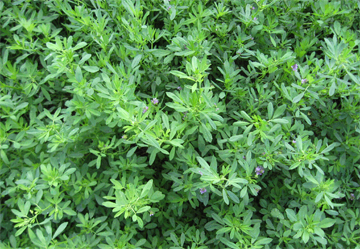
possible. Weather, insect, weed, and other problems will most likely make it necessary to put up at least some of the hay produced as round bales. As a result, potential alfalfa growers should be realistic in their price expectations and use a projected sales price that accurately reflects the sales prices for round and square bales and the amounts of each type of hay that is sold.
Alfalfa Feeding Values
If the hay is to be used for feed on the farm where it is produced, compare the feed value of the hay with the cost of a feed that can be purchased. As alfalfa can be a very high-quality feed, it is usually considered a cost-effective feed when grown on farm.
Summary
Alfalfa is a perennial legume forage crop that can be successfully grown on well-drained and fertile soils throughout the state. Alfalfa forage has a high energy value and protein content and can be used as a cost-effective feedstuff in many forage-based livestock systems in Georgia.
Good management is critical to successful alfalfa production. The crop must be harvested at the correct stage of growth to produce quality feed and maintain healthy, productive stands. Lime and fertilizer requirements must be met and insects and weeds must be controlled. Well-managed alfalfa fields may produce more than six tons of hay per acre in a good growing season, and stands should persist for 3 to 5 years in south Georgia and 4 to 7 years in north Georgia.
When well-managed, alfalfa is a high-value crop that can be profitably produced for the cash hay market or stored as hay or silage for on-farm use.
Status and Revision History
Published on Jan 09, 2009
Published with Full Review on Jan 09, 2012
Published with Full Review on Jan 23, 2015


























































